“My guitar is not a thing,” Joan Jett famously declared, encapsulating the profound connection musicians have with their instruments. “It is an extension of myself. It is who I am.” The guitar, in its universal appeal, primal resonance, and expressive capacity, stands as a testament to human creativity. While anyone can learn a few chords quickly, mastering the guitar is a lifelong journey of exploration. This enduring allure makes the discussion of what constitutes a truly great guitarist endlessly fascinating.
In 2011, Rolling Stone, a leading voice in music journalism, published its inaugural list of the 100 Greatest Guitarists. This compilation, curated by a panel of seasoned musicians predominantly from the classic rock era, became a benchmark for evaluating guitar virtuosity. Building upon this legacy, Rolling Stone has now unveiled an expanded and updated list, crafted by its editors and writers, reaching an impressive 250 guitarists. This new compilation aims to showcase the vast evolution of the guitar across genres and generations.
Guitarists often attain iconic status mirroring that of lead vocalists, becoming synonymous with the bands they anchor. Mythic figures like Jimmy Page, Brian May, and Eddie Van Halen represent just one facet of the guitar’s rich narrative. Rolling Stone‘s expanded list endeavors to illustrate the instrument’s extensive scope and history. Spanning from folk music pioneer Elizabeth Cotten, born in 1893, to indie-rock innovator Lindsey Jordan, born in 1999, the list encompasses a breathtaking array of genres. From rock, jazz, reggae, and country to folk, blues, punk, metal, disco, funk, bossa nova, bachata, Congolese rumba, and flamenco, the diversity is staggering. It celebrates both unparalleled virtuosos like Pat Metheny, Yvette Young, and Steve Vai, and raw, primal players such as Johnny Ramone and Poison Ivy of the Cramps. The list also honors mainstream luminaries like Prince, Joni Mitchell, and Neil Young, alongside unsung heroes like Memphis soul maestro Teenie Hodges and smooth-rock craftsman Larry Carlton.
Acknowledging the collaborative spirit of music, Rolling Stone recognizes the significant contributions of guitar duos. Entries celebrate symbiotic partnerships such as Kim and Kelley Deal of the Breeders, Adrian Smith and Dave Murray of Iron Maiden, and others who have amplified each other’s creativity. The sole criterion for inclusion remains mastery of the six-string guitar, a nod to its enduring prominence in music history.
In assembling this list, Rolling Stone prioritized certain qualities: heaviness over technical polish, genuine feel over sterile perfection, and groundbreaking innovation over mere refinement. Above all, the list leans towards artists who channeled their unique talents into crafting exceptional songs and albums that redefined musical landscapes, rather than simply showcasing technical prowess.
As modern blues visionary Gary Clark Jr. aptly stated, “I don’t know if I want to get too far off the path — I don’t want to get lost in the forest — but I like to wander out a bit and adventure.” This spirit of exploration and innovation resonates throughout Rolling Stone‘s selection of the 250 Greatest Guitarists, a testament to the instrument’s boundless potential.
Andy Summers: Jazz Inflections in Rock Power Trios
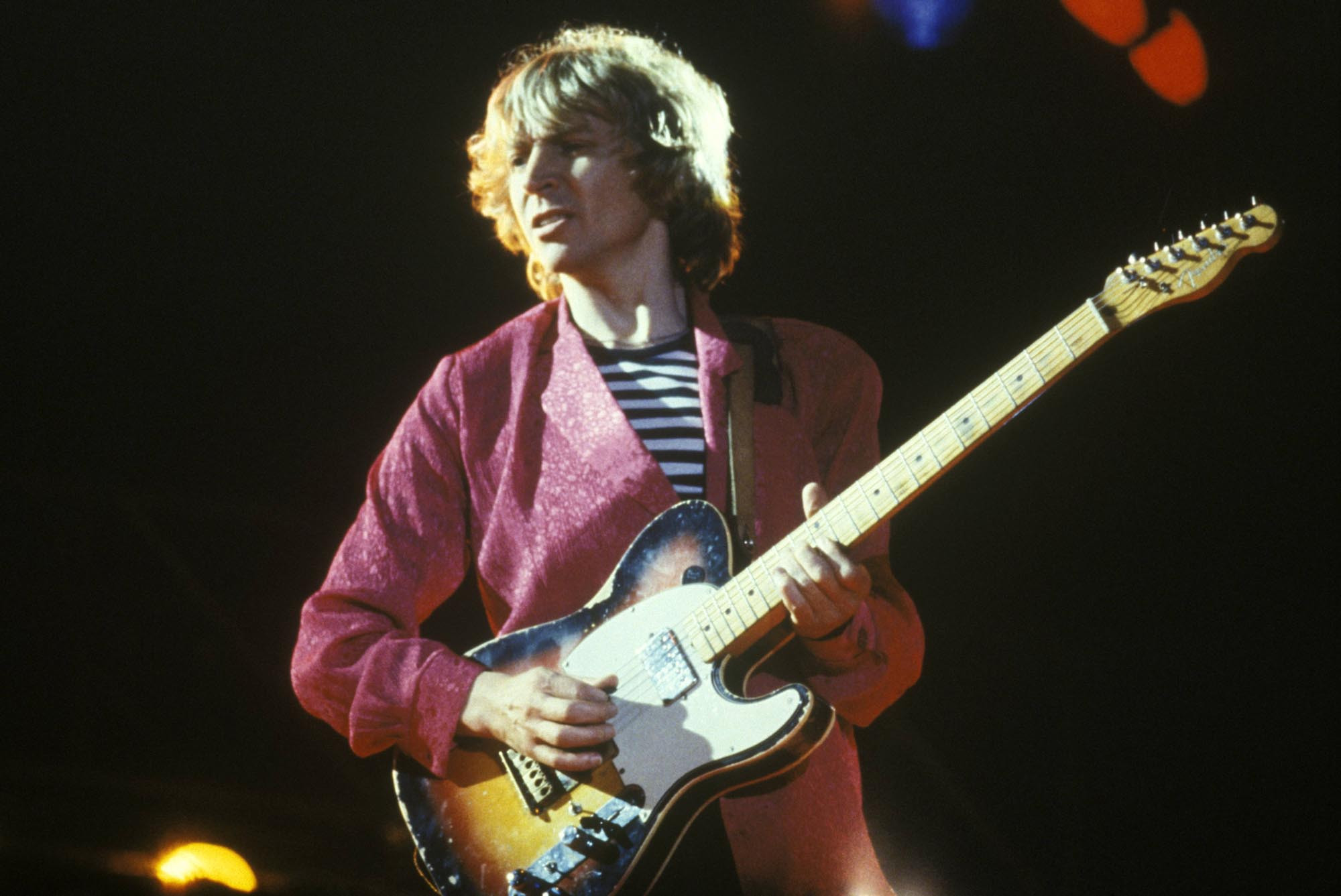 Andy Summers of The Police performing live at Hammersmith Odeon, London, playing a Fender Telecaster guitar, highlighting his jazz chords and reggae rhythms in rock music.
Andy Summers of The Police performing live at Hammersmith Odeon, London, playing a Fender Telecaster guitar, highlighting his jazz chords and reggae rhythms in rock music.
Image Credit: Graham Wiltshire/Redferns/Getty Images
The Police emerged as a novel force in the power trio format, largely due to the distinctive guitar work of Andy Summers. Moving swiftly beyond punk’s rudimentary structures, Summers integrated jazz chord voicings and reggae-infused rhythms into a potent rock and roll framework. His playing was characterized by its economy and precision, constructing sparse, clipped sonic gestures and dub-influenced washes of sound, creating ample sonic space for Sting’s vocals and Stewart Copeland’s dynamic drumming. “His tone and style were just absolutely perfect — he left space around everything,” remarked Alex Lifeson of Rush, praising Summers’ approach. “And he can handle anything from beautiful acoustic playing to jazz to hybrid kinds of stuff.” Summers’ ability to blend genres seamlessly and his emphasis on sonic architecture cemented his place as a guitar innovator.
Key Tracks: “Message in a Bottle,” “Every Breath You Take”
Brittany Howard: Earthy Grit and Soulful Versatility
 Brittany Howard of Alabama Shakes, photographed for Rolling Stone, showcasing her earthy and fluid guitar style that complements her powerful vocals and soulful songwriting.
Brittany Howard of Alabama Shakes, photographed for Rolling Stone, showcasing her earthy and fluid guitar style that complements her powerful vocals and soulful songwriting.
Image Credit: Sacha Lecca for Rolling Stone
From her beginnings with the garage-roots ensemble Alabama Shakes, Brittany Howard’s guitar playing has consistently been an organic, flowing, and admirably spontaneous complement to her commanding vocals and deeply soulful songwriting. Her rhythmic sensibility is remarkably elastic, evident in the dynamic interplay between her robust, jagged guitar lines and Heath Fogg’s lead guitar work on the Alabama Shakes’ 2015 track “Don’t Wanna Fight.” Howard expanded her musical palette into straightforward rock and roll with her side project Thunderbitch. Her critically acclaimed 2019 solo album, Jaime, served as a compelling showcase for her expansive musicianship, ranging from the James Brown-inspired funk hopscotch of “History Repeats” to the dense, molten fuzz textures applied to “Presence.” Howard’s guitar work is defined by its raw emotion and genre-bending exploration.
Key Tracks: “History Repeats,” “Presence”
Robby Krieger: Flamenco Flair in The Doors’ Psychedelic Soundscapes
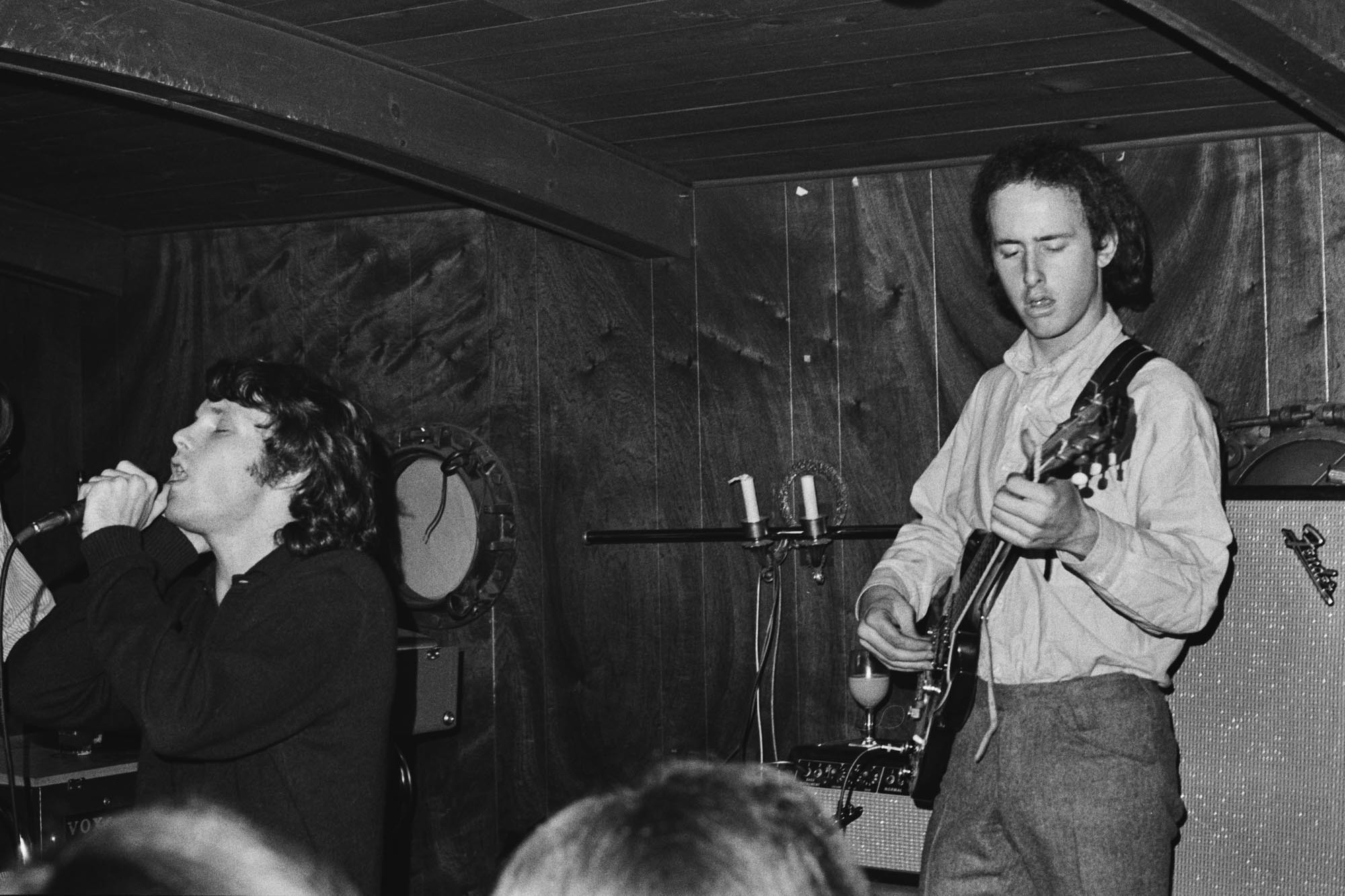 Robby Krieger of The Doors performing at the Ondine Club in New York City in 1966, demonstrating his flamenco and jazz influenced guitar playing in rock music.
Robby Krieger of The Doors performing at the Ondine Club in New York City in 1966, demonstrating his flamenco and jazz influenced guitar playing in rock music.
Image Credit: Don Paulsen/Michael Ochs Archives/Getty Images
Robby Krieger, whose musical foundation was rooted in flamenco and jazz, ventured beyond the conventional boundaries of rock guitar at a time when many players remained tethered to blues traditions. As the guitarist for The Doors, Krieger possessed the improvisational agility to follow Jim Morrison’s unpredictable artistic explorations. He also contributed significantly to the band’s songwriting, penning some of their most enduring hits, including “Light My Fire.” In The Doors’ unconventional lineup, lacking a bassist, Krieger adeptly filled the sonic void. “Not having a bass player … made me play more bass notes to fill out the bottom,” he explained. “Not having a rhythm player also made me play differently, to fill out the sound. I always felt like three players simultaneously.” Krieger’s innovative approach to rhythm and melody was crucial to The Doors’ signature sound.
Key Tracks: “Riders on the Storm,” “Roadhouse Blues”
Ricky Wilson: New Wave Innovation with Spartan Sounds
 Ricky Wilson of The B-52s performing live in Athens, Georgia in 1978, playing his blue Mosrite guitar and showcasing his inventive mix of surf rock, rockabilly, and post-punk styles.
Ricky Wilson of The B-52s performing live in Athens, Georgia in 1978, playing his blue Mosrite guitar and showcasing his inventive mix of surf rock, rockabilly, and post-punk styles.
Image Credit: Tom Hill/WireImage
In the live performances of the B-52s, Ricky Wilson often appeared content to remain in the background, amidst the flamboyant stage presence of lead singer Fred Schneider and the iconic beehive hairstyles and campy choreography of Kate Pierson and Cindy Wilson. However, his distinctive guitar style, a unique blend of down-home chicken scratch, angular post-punk sensibilities, rockabilly energy, and surf rock twang, defined the band’s sound on classics such as “52 Girls,” “Strobe Light,” and “Private Idaho.” Wilson’s unconventional approach extended to his instrument itself; he frequently used only four or five strings on his blue Mosrite guitar and employed unusual tunings to achieve a strange, minimalist sonic texture. “I just tune the strings till I hear something I like,” he once remarked, reflecting his intuitive and experimental nature. His untimely passing in 1985 marked the loss of an understated but radical innovator within the indie-rock scene.
Key Tracks: “52 Girls,” “Mesopotamia”
Paul Simon: Acoustic Mastery and Global Rhythms
 Paul Simon performing onstage in Chicago in 1980, playing acoustic guitar and demonstrating his evolution from folk revival to incorporating global musical influences.
Paul Simon performing onstage in Chicago in 1980, playing acoustic guitar and demonstrating his evolution from folk revival to incorporating global musical influences.
Image Credit: Paul Natkin/Getty Images
Paul Simon, celebrated as a masterful lyricist, expresses himself just as vividly through his guitar work. Influenced by early doo-wop and rock & roll, Simon became deeply involved in the folk revival movement of the mid-Sixties, traveling to England to study the acoustic guitar techniques of Bert Jansch. He has consistently absorbed new musical influences throughout his career, as exemplified in “Dazzling Blue” from his album So Beautiful or So What. Reflecting on this track, Simon noted, “All that folk fingerpicking is what I did with Simon and Garfunkel, but [here] it’s on top of this rhythm with Indian musicians playing in 12/8.” Even in his eighties, Simon’s guitar skills remain remarkably agile, as demonstrated on his 2023 album Seven Psalms, showcasing his enduring creativity and technical prowess.
Key Tracks: “Dazzling Blue,” “Kathy’s Song”
Leslie West: Heavy Blues Power with Mountain
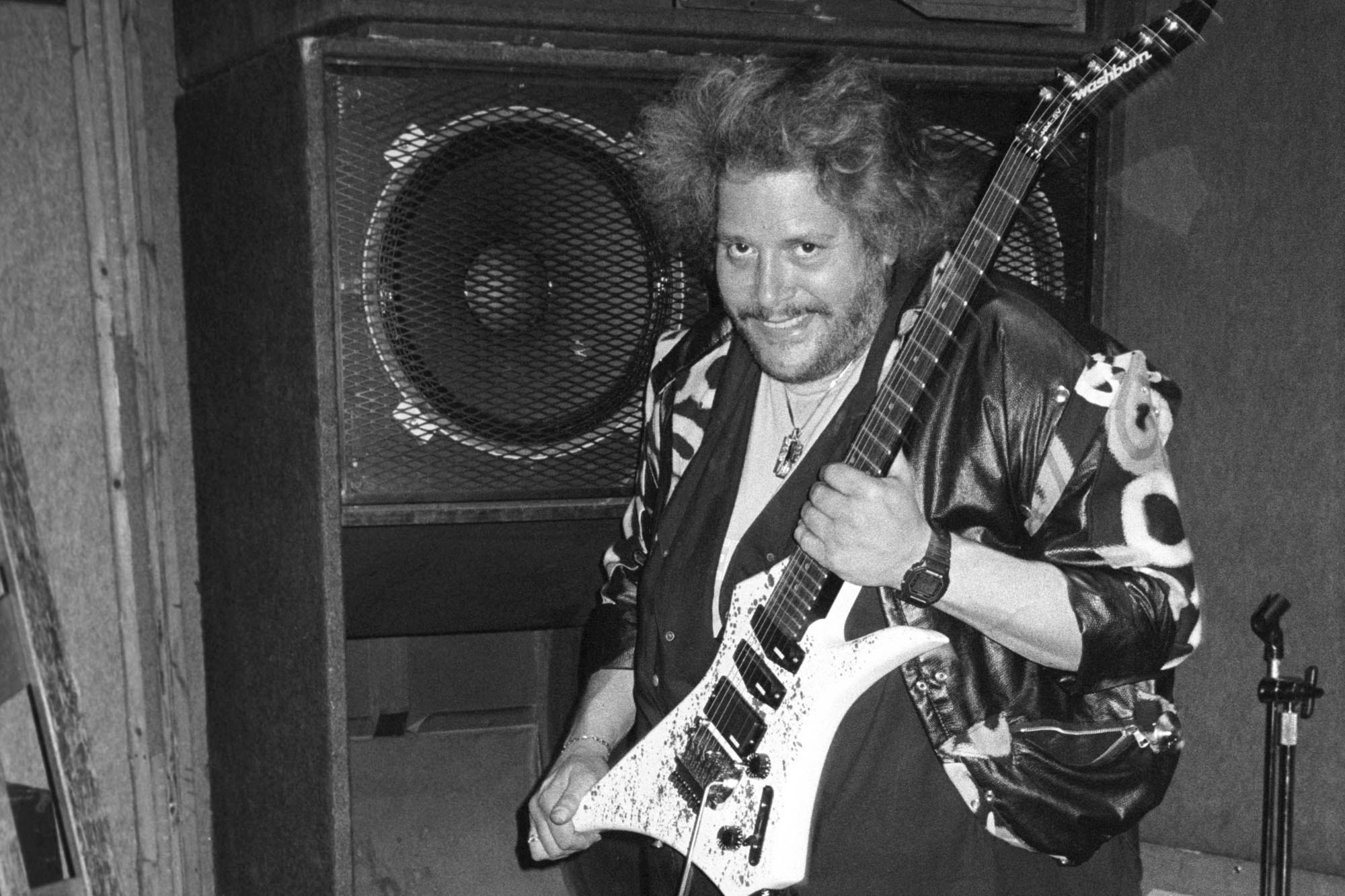 Leslie West of Mountain performing live in the United Kingdom, playing guitar and showcasing his heavy blues lines and stressed-amp distortion sound.
Leslie West of Mountain performing live in the United Kingdom, playing guitar and showcasing his heavy blues lines and stressed-amp distortion sound.
Image Credit: Erica Echenberg/Redferns/Getty Images
Leslie West (born Leslie Weinstein) first gained attention in the mid-Sixties garage rock scene with the Vagrants’ powerful cover of Otis Redding’s “Respect.” By 1969, West became the driving force in the Cream-inspired quartet Mountain, injecting a heavier, more aggressive sound into the rock landscape. On Mountain’s 1970 hit “Mississippi Queen,” West delivered raw, blues-infused guitar lines with deceptive ease and a distinct R&B sensibility, all channeled through a wall of stressed-amplifier distortion. “The riffs were incredible,” remarked Dave Davies of The Kinks. “He could play flashy, intricate phrases. But he wasn’t a look-at-me guy. He played with feel.” West’s ability to combine technical skill with raw emotion defined his impactful guitar style.
Key Tracks: “Mississippi Queen,” “Nantucket Sleighride (To Owen Coffin)”
Edilio Paredes: Bachata’s Guitar Maestro
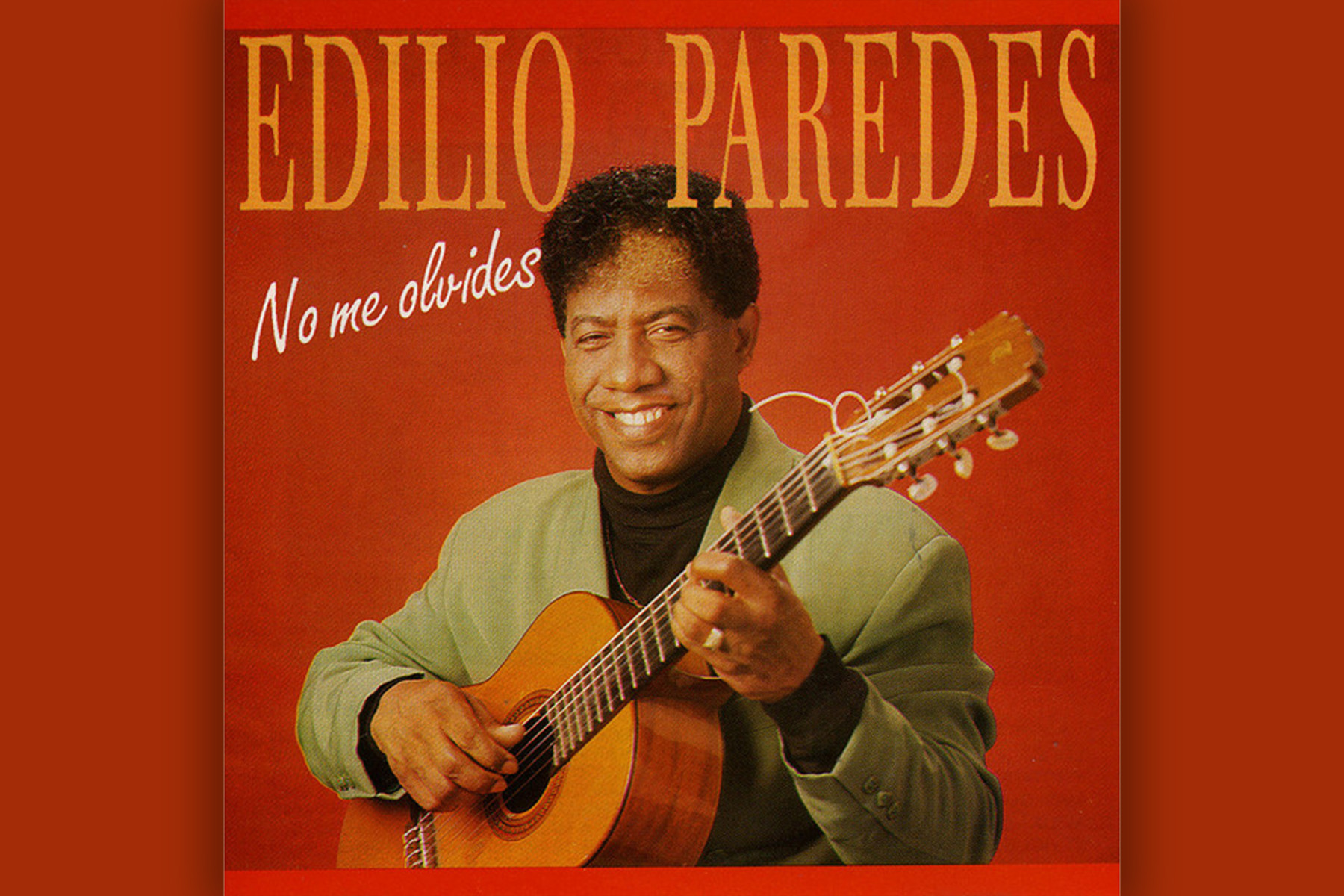 Edilio Paredes, photographed for Rolling Stone, highlighting his role in shaping the sound of bachata music with his distinctive guitar lines.
Edilio Paredes, photographed for Rolling Stone, highlighting his role in shaping the sound of bachata music with his distinctive guitar lines.
The global popularity of bachata, recently propelled by pop stars like Rosalía and the Weeknd, belies its origins as a genre largely unknown outside its native Dominican Republic. Edilio Paredes is the architect of la música del amargue‘s sonic identity, crafting the genre’s signature pungent, spiraling guitar lines that weave and emphasize the poignant themes of lost love. A self-taught prodigy, Paredes was instrumental in transitioning bachata from bolero campesino to the contemporary form that achieved international recognition as a transcendent Afro-Caribbean genre in the 1990s. Paredes’ extensive discography as a sought-after session musician from the 1960s to the 1980s speaks volumes about his influence, further solidified by his appearance on the acclaimed 2011 album The Bachata Legends. His guitar work is synonymous with the emotional core of bachata music.
Key Tracks: “No Me Olvides,” “Bendita Nena”
Aaron Dessner and Bryce Dessner: Twin Guitar Virtuosity in The National
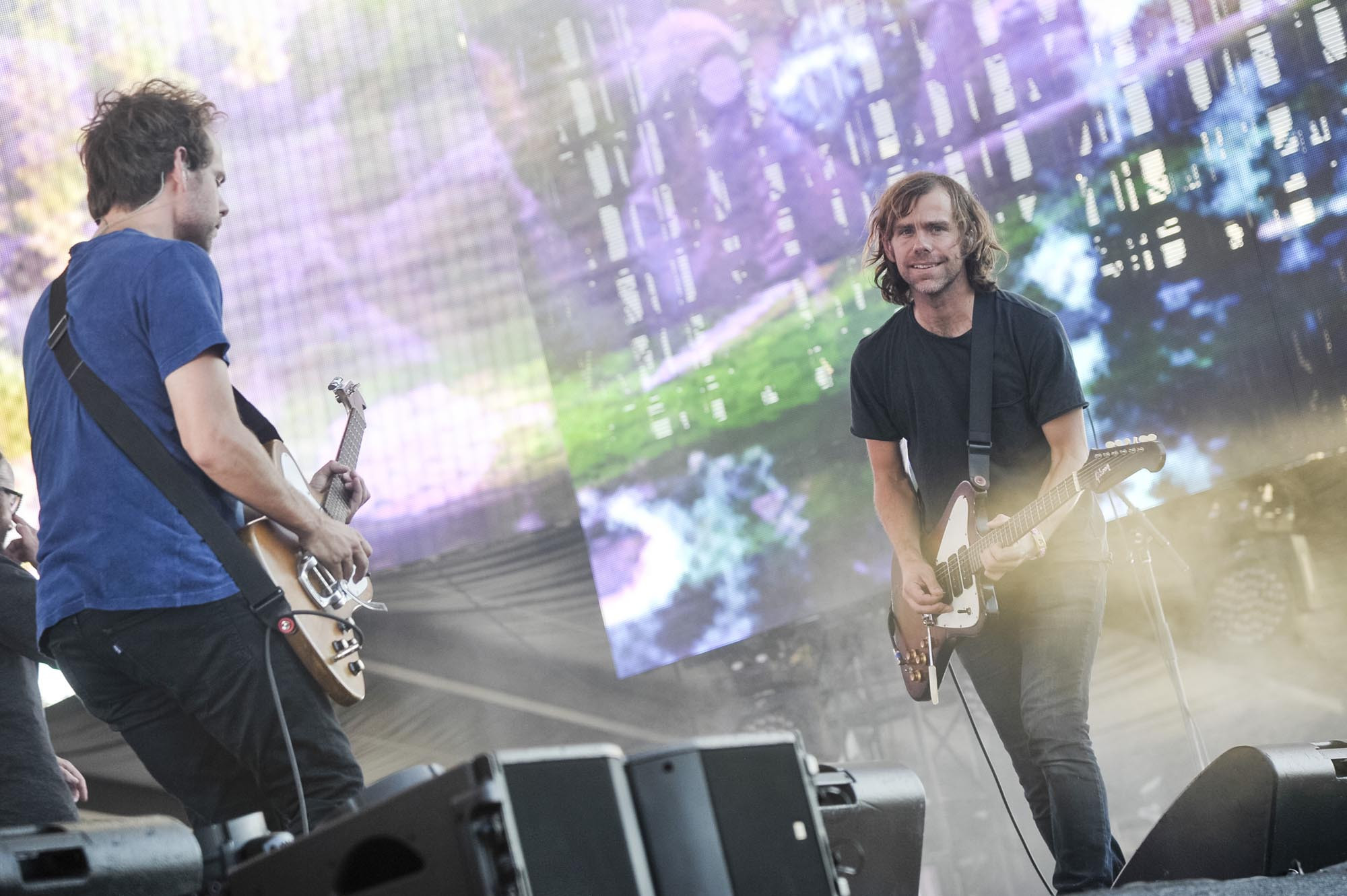 Aaron and Bryce Dessner of The National performing at Panorama NYC in 2016, showcasing their virtuosic twin-guitar dynamic and contributions to indie and alternative rock.
Aaron and Bryce Dessner of The National performing at Panorama NYC in 2016, showcasing their virtuosic twin-guitar dynamic and contributions to indie and alternative rock.
Image Credit: Kris Connor/FilmMagic
The National represents a unique narrative in rock music, centered around the virtuosic twin-guitar partnership of twin brothers Aaron and Bryce Dessner. Bryce Dessner’s collaborative portfolio includes work with luminaries such as Steve Reich, Ryuichi Sakamoto, Jonny Greenwood, and the Kronos Quartet, highlighting his diverse musical range. Aaron Dessner has become Taylor Swift’s key guitar collaborator on Folklore and Evermore, contributing Jerry Garcia-esque twang to tracks like “Cowboy Like Me” and unleashing more unrestrained guitar work on “August” in The Long Pond Studio Sessions. Together, the Dessner brothers create a dynamic range, from electric intensity in tracks like “Terrible Love” to intimate folk beauty in “I Need My Girl.” They also spearheaded the celebrated 2016 Grateful Dead tribute album Day of the Dead, jamming with Bob Weir on “I Know You Rider,” demonstrating their versatility and collaborative spirit.
Key Tracks: “Mr. November,” “Bloodbuzz Ohio,” “The System Only Dreams in Total Darkness”
Lindsey Jordan: Indie Rock Prodigy and Shredding Virtuoso
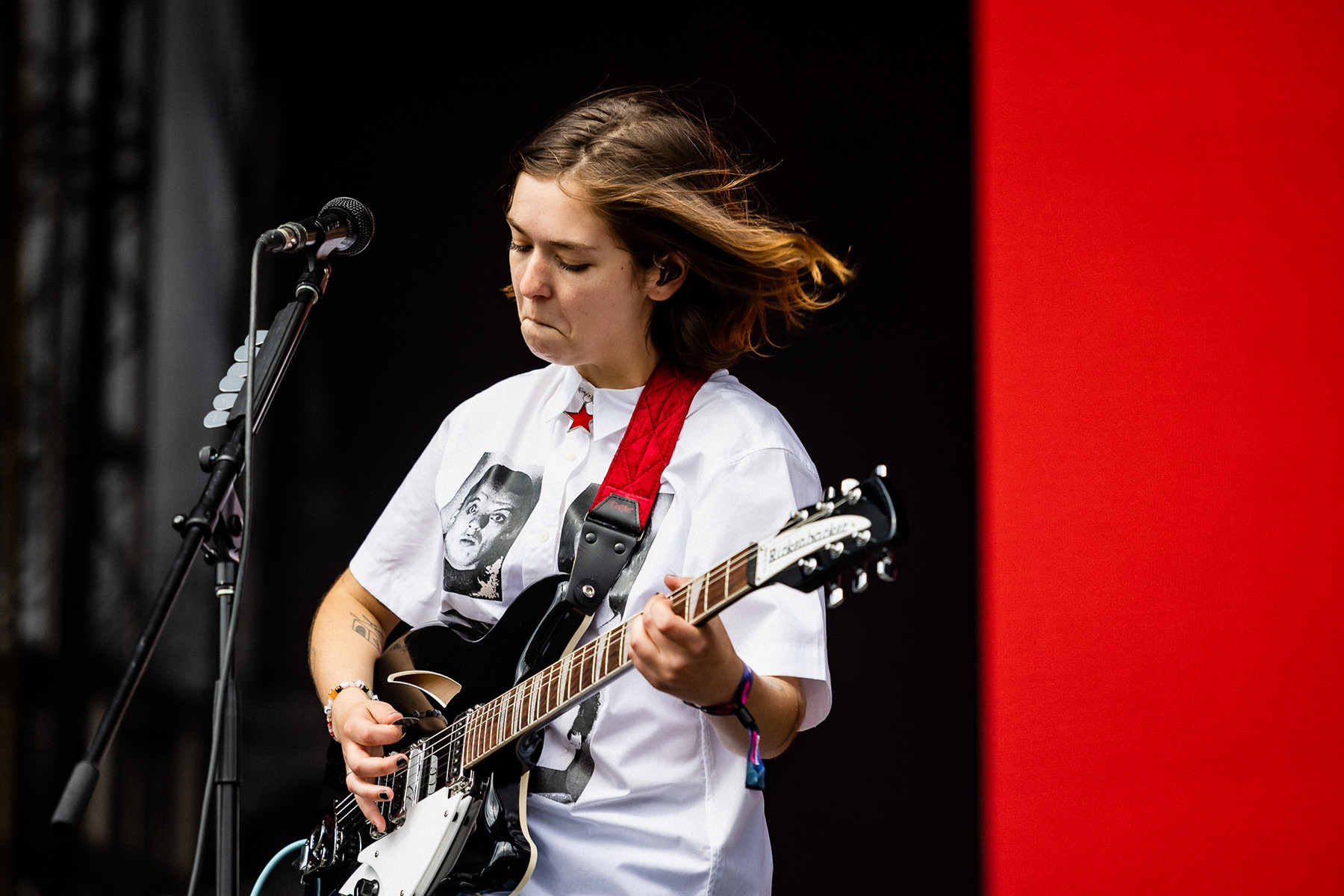 Lindsey Jordan of Snail Mail performing at Governors Ball in 2023, playing guitar and demonstrating her indie-rock virtuosity and shredding capabilities.
Lindsey Jordan of Snail Mail performing at Governors Ball in 2023, playing guitar and demonstrating her indie-rock virtuosity and shredding capabilities.
Image Credit: Griffin Lotz for Rolling Stone
Lindsey Jordan, a Gen Z guitar hero performing as Snail Mail, honed her skills under the tutelage of Mary Timony, a fellow Rolling Stone 250 Greatest Guitarists list member known for her inventive guitar work in Helium and Wild Flag. Jordan’s debut as Snail Mail at age 18 with 2018’s Lush suggested a fully formed indie-rock sensibility, seemingly having absorbed the genre’s entire canon. She is both a casual virtuoso and a serious shredder, seamlessly transitioning from strummed tension-building passages to explosive, glorious solos, and moving between coolly detached Liz Phair-esque lo-fi textures and Sonic Youth-inspired sonic sprawl. “I like to play really balls out,” she told Rolling Stone in 2018. “That’s what it means to be onstage with integrity.” Jordan’s dynamic and emotionally charged guitar playing positions her as a leading figure in contemporary indie rock.
Key Tracks: “Heat Wave,” “Pristine”
Keith Urban: Effortless Country Style and Rock Heroics
 Keith Urban performing at The Bottom Line in New York City in 2001, playing guitar and showcasing his effortless style and blend of country and rock guitar techniques.
Keith Urban performing at The Bottom Line in New York City in 2001, playing guitar and showcasing his effortless style and blend of country and rock guitar techniques.
Image Credit: Frank Micelotta/Getty Images
Keith Urban, while perhaps not country music’s most technically flashy or traditional player, distinguishes himself among Nashville’s guitar elite with his seemingly effortless style. His riffs, rhythms, and solos appear to emerge as naturally as thought itself, consistently elevating the song’s emotional impact. Nothing in Urban’s playing feels overtly showy; every note serves a purpose, contributing to the overall musical narrative. Tracks like “Blue Ain’t Your Color” and “Highway Don’t Care” exemplify his studio finesse. However, Urban truly shines onstage, delivering guitar heroics that rival the legends of rock. His versatility has led to collaborations with artists ranging from the Rolling Stones to Nile Rodgers. “I love that people want to hear the guitar,” Urban told Rolling Stone in 2015, “but I just think about the song … whatever the song seems to want.” His song-centric approach and versatile guitar skills have made him a prominent figure in modern country music.
Key Tracks: “Highway Don’t Care,” “Blue Ain’t Your Color”
Erin Smith: Riot Grrrl Guitar Pioneer
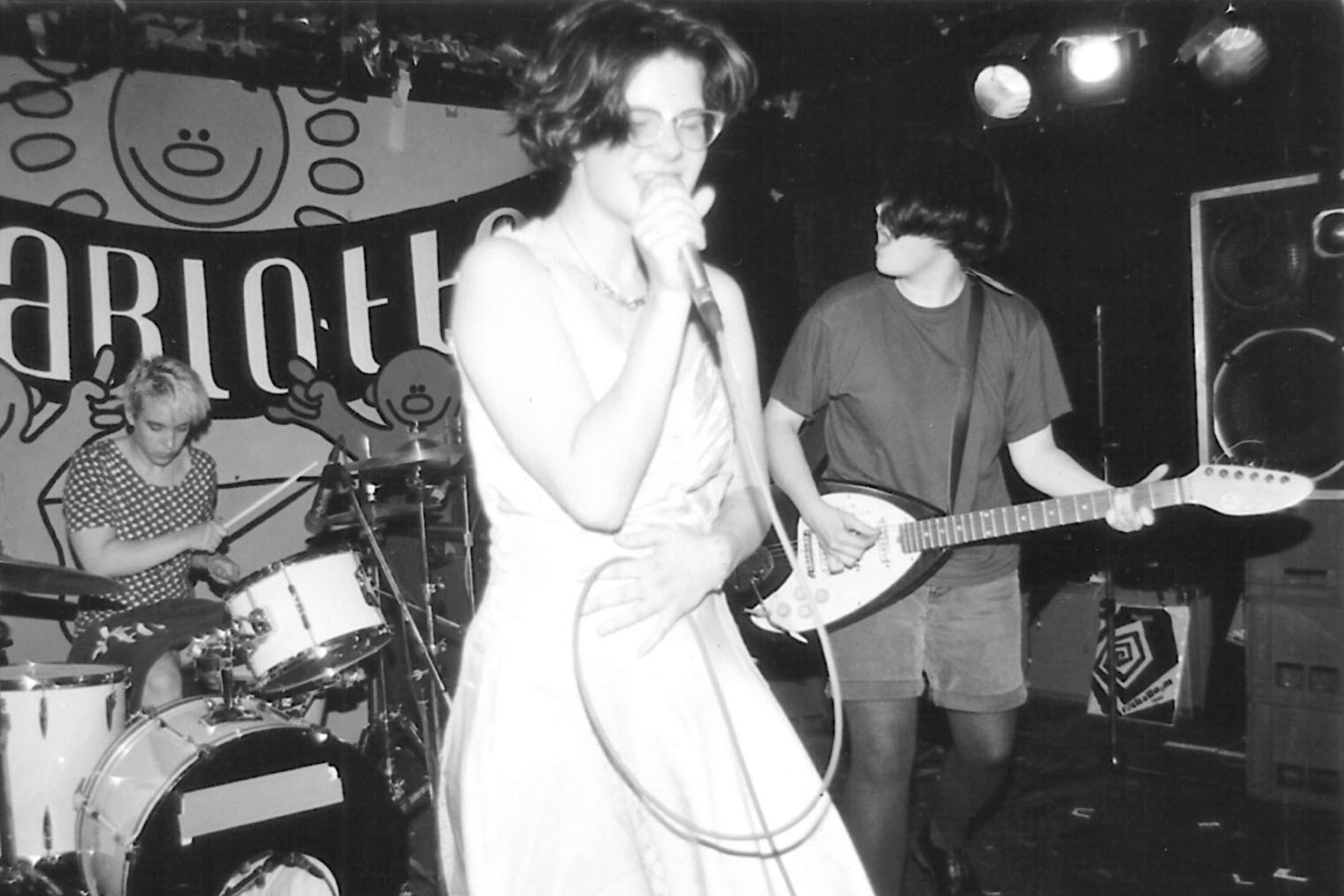 Erin Smith of Bratmobile, photographed by Greg Neate, showcasing her role as a riot grrrl pioneer and her melodic surf-rock bass lines combined with garage-rock chords.
Erin Smith of Bratmobile, photographed by Greg Neate, showcasing her role as a riot grrrl pioneer and her melodic surf-rock bass lines combined with garage-rock chords.
Image Credit: © Greg Neate/neatephotos.com/flickr CC BY 2.0
Erin Smith, guitarist for riot grrrl pioneers Bratmobile, began her musical journey playing along to records by Beat Happening, a self-consciously primitive cuddle-core band featuring a female drummer. “That was in ’87, and not only did I see women could play music, but I could see that just you could do it yourself,” she told the Museum of Pop Culture. “I could never be [Duran Duran’s] Andy Taylor. And I realized that was OK.” The style she developed with singer Allison Wolfe and drummer Molly Neuman combined melodic surf-rock-influenced bass lines with raw, slashing garage-rock chords, contributing to Bratmobile’s seminal 1993 debut album, Pottymouth, a landmark punk record of the Nineties. Smith’s guitar work was essential to the sound and ethos of the riot grrrl movement.
Key Tracks: “Love Thing,” “P.R.D.C.T.”
Duane Eddy: The Twang King and Rock & Roll Guitar Icon
 Duane Eddy posing for a portrait in New York City in 1958, playing guitar and highlighting his signature twangy guitar sound and tremolo techniques in early rock and roll.
Duane Eddy posing for a portrait in New York City in 1958, playing guitar and highlighting his signature twangy guitar sound and tremolo techniques in early rock and roll.
Image Credit: PoPsie Randolph/Michael Ochs Archives/Getty Images
If any doubt lingered in the late 1950s about the guitar’s ascendance as rock & roll’s defining lead instrument, Duane Eddy decisively settled the debate. His 1958 single “Rebel Rouser,” characterized by its country-infused twang and rippling tremolo, became an instant classic. “Chet Atkins used vibrato in a selective way — Duane Eddy used it to thrash the music,” noted Dave Davies of The Kinks, emphasizing Eddy’s distinctive and impactful use of tremolo. Eddy’s hits, including “Forty Miles of Bad Road” and “Peter Gunn,” profoundly influenced surf music and guitarists such as Jeff Beck and George Harrison, solidifying his legacy as the “Twang King” and a pivotal figure in early rock guitar.
Key Tracks: “Rebel Rouser,” “Peter Gunn”
Doug Gillard: Guided By Voices’ Indie Rock Heartbeat
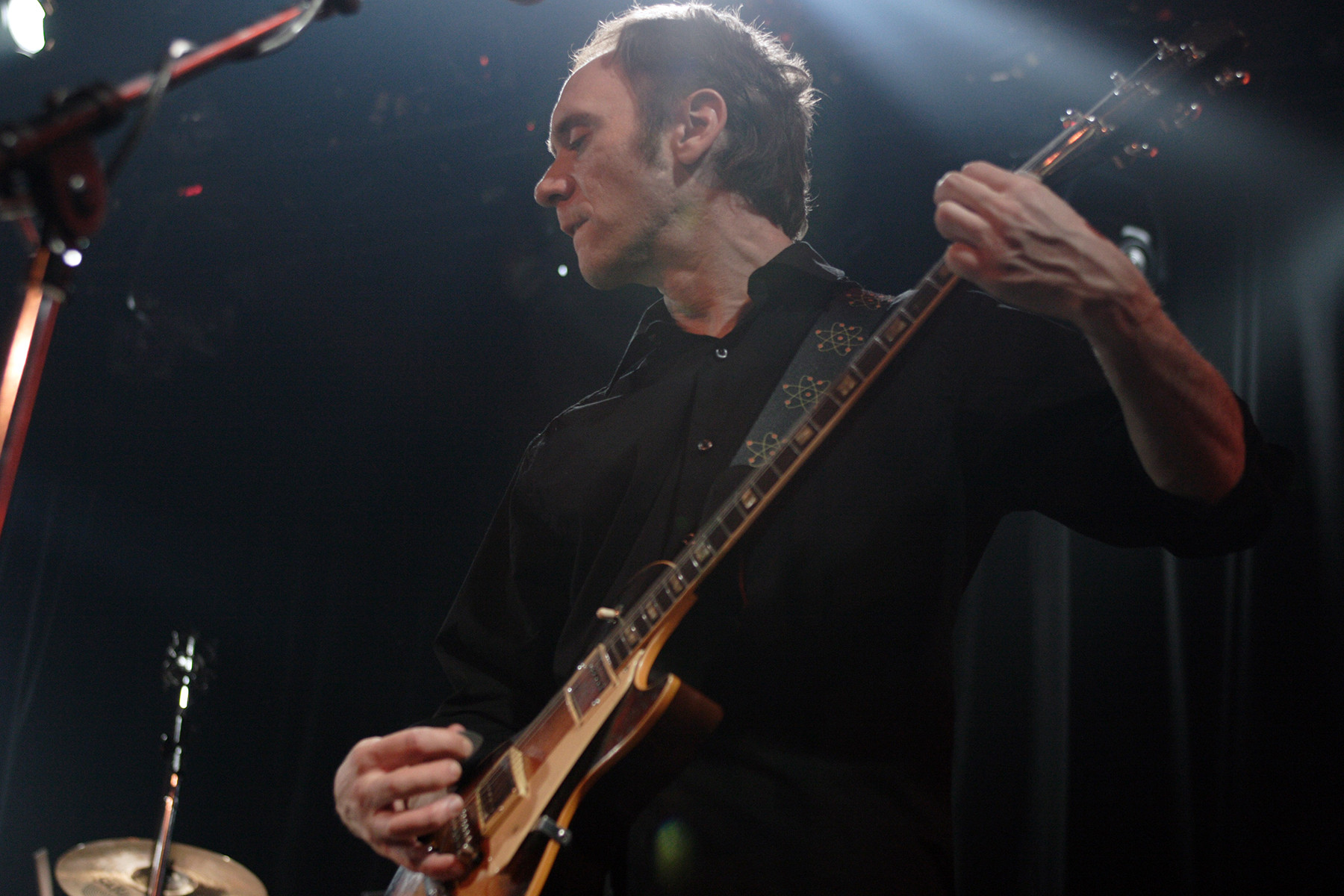 Doug Gillard of Guided by Voices performing in Chicago in 2004, playing guitar and showcasing his role as the band's musical heart and his collaboration with Robert Pollard.
Doug Gillard of Guided by Voices performing in Chicago in 2004, playing guitar and showcasing his role as the band's musical heart and his collaboration with Robert Pollard.
Image Credit: Matt Carmichael/Getty Images
In the context of Ohio indie-rock institution Guided By Voices, Robert Pollard embodies the band’s eccentric genius, while Doug Gillard serves as the band’s musical heartbeat. Gillard is the ideal complement to Pollard’s often unconventional songwriting, transforming Pollard’s wordplay and experimental sonic ideas into cohesive rock and roll structures, maintaining a prolific output of two to three GBV albums annually. “I know his usual shapes and drones — or can pretty much decipher what they are if it’s a new shape — and replicate them on the rhythm parts on the records for the most part,” Gillard once explained. “But also, I have some freedom to transform them.” His ability to interpret and enhance Pollard’s vision makes him a crucial component of Guided By Voices’ enduring appeal.
Key Tracks: “I Am a Tree,” “Mr. Child”
Jennifer Batten: Guitar Hurricane and Virtuoso Showmanship
Image Credit: Catherine McGann/Getty Images
Jennifer Batten rose to prominence as the visually striking and technically formidable guitarist on Michael Jackson’s monumental world tours. This role demanded exceptional versatility, requiring her to navigate funk, soul, metal, and perform Eddie Van Halen’s iconic “Beat It” solo nightly. Her debut solo album, 1992’s Above Below and Beyond, showcased her eclectic range, featuring her electric guitar interpretations of Rimsky-Korsakov’s “Flight of the Bumble Bee,” Jackson’s “Wanna Be Startin’ Somethin’,” and John Coltrane’s “Giant Steps,” all infused with her signature whammy bar techniques and finger-tapping pyrotechnics. Batten later joined forces with guitar legend Jeff Beck, touring and recording with him on some of his most adventurous albums around the turn of the millennium, further cementing her status as a guitar virtuoso capable of collaborating with the best.
Key Tracks: “Flight of the Bumblebee,” “Giant Steps (Rock Version)”
Greg Sage: Wipers’ Pioneer of Pacific Northwest Indie Rock
 Greg Sage of The Wipers performing live in Amsterdam in 1986, playing guitar and highlighting his pioneering role in Pacific Northwest indie rock and his influence on Kurt Cobain.
Greg Sage of The Wipers performing live in Amsterdam in 1986, playing guitar and highlighting his pioneering role in Pacific Northwest indie rock and his influence on Kurt Cobain.
Image Credit: Frans Schellekens/Redferns/Getty Images
Greg Sage formed his Portland, Oregon band the Wipers in 1977, pushing beyond punk conventions before they were even fully established. His complex, sprawling song structures and jagged, distorted guitar sound were ahead of their time. In an era where simplicity was often prized, Wipers songs like “When It’s Over” and “Romeo” created immersive, pummeling sonic landscapes. Consequently, the Wipers galvanized the Pacific Northwestern indie-rock scene, profoundly influencing bands that followed. “We learned everything from the Wipers,” Kurt Cobain stated, proudly declaring them his favorite band. “They were playing a mix of punk and hard rock when nobody cared.” Sage’s pioneering vision shaped the sound of indie rock in the Pacific Northwest and beyond.
Key Tracks: “When It’s Over,” “Up Front”
Laura Marling: Subtle Virtuosity and Intricate Tunings
Image Credit: Chiaki Nozu/WireImage
British singer-songwriter and multi-instrumentalist Laura Marling embodies a more understated form of virtuosity, employing complex tunings and voicings in her music that often sound deceptively simple. “I Was an Eagle,” from her 2013 album One I Was an Eagle, achieves its dreamy and atmospheric quality through her use of DADDAD tuning. The influence of Joni Mitchell is palpable in Marling’s work, evident in her unusual phrasing and atonal flourishes. During the Covid-19 lockdown, Marling shared her guitar expertise with fans, offering concise and informative tutorials on Instagram, further demonstrating her commitment to her craft and her willingness to share her knowledge. Her subtle yet sophisticated guitar work is a hallmark of her distinctive musical style.
Key Tracks: “I Was an Eagle,” “Wild Fire,” “Ghosts”
John McGeoch: Post-Punk Guitar Architect
 John McGeoch of Siouxsie and the Banshees performing at Palladium in New York City in 1980, playing guitar and showcasing his architectural and atmospheric guitar style in post-punk and goth music.
John McGeoch of Siouxsie and the Banshees performing at Palladium in New York City in 1980, playing guitar and showcasing his architectural and atmospheric guitar style in post-punk and goth music.
Image Credit: Ebet Roberts/Redferns/Getty Images
John McGeoch, originating from Manchester, England, made a striking entrance with the soaring guitar attack on Magazine’s 1978 debut single, “Shot by Both Sides,” a defining anthem of UK punk rock. He rapidly developed his own expansive and architecturally structured style, evident in Magazine’s subsequent work, as well as his contributions to Public Image Ltd and Siouxsie and the Banshees. McGeoch earned fervent admiration from guitarists like Johnny Marr and Radiohead’s Ed O’Brien. His signature blend of slashing rhythm guitar, swirling arpeggios, and miasmic flanging defined the Banshees’ 1981 album, Juju, considered a cornerstone of Eighties goth-guitar music, introducing a moody and atmospheric language to UK rock that prioritized atmosphere over overt angst. McGeoch’s innovative guitar textures had a lasting impact on post-punk and goth genres.
Key Tracks: “Philadelphia,” “Spellbound”
H.E.R.: R&B Ballads and Prince-like Shredding
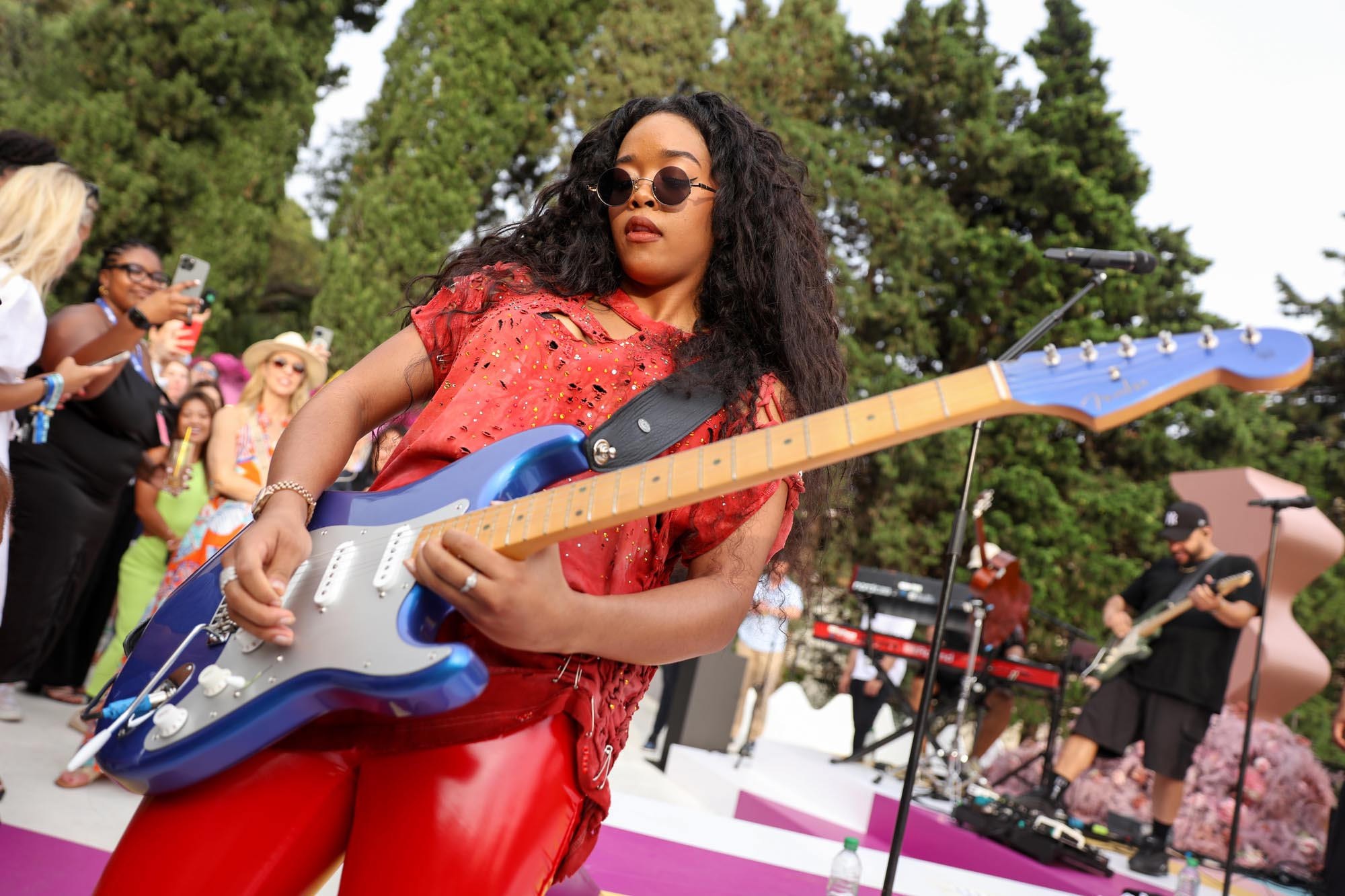 H.E.R. performing at Spotify event in Cannes, France, playing guitar and highlighting her versatile guitar skills ranging from R&B melodies to Prince-inspired rock shredding.
H.E.R. performing at Spotify event in Cannes, France, playing guitar and highlighting her versatile guitar skills ranging from R&B melodies to Prince-inspired rock shredding.
Image Credit: David M. Benett/Getty Images
H.E.R. maintains a relatively low profile, consistently surprising audiences with each major public appearance, such as at the Grammys or the Super Bowl. Her vocal style is deeply rooted in classic R&B, and she is known for her simmering ballads, but her guitar playing is remarkably versatile, spanning delicate and fluid accents to Prince-esque rock shredding. Her single “Hold On” exemplifies her style, featuring her doubling her vocal melodies with a series of soaring lead guitar lines, a characteristic element of her sound. “I also like to play my guitar like I’m singing,” she told Guitar World. “Sometimes, I like to sing and play my solos at the same time … even harmonizing my voice with my guitar.” In 2021, Fender honored H.E.R. with a signature Stratocaster model, making her the first Black woman to receive this distinction, recognizing her significant impact on contemporary guitar music.
Key Tracks: “Hold On,” “Comfortable”
David Williams: The Spare Spice of Eighties Pop Hits
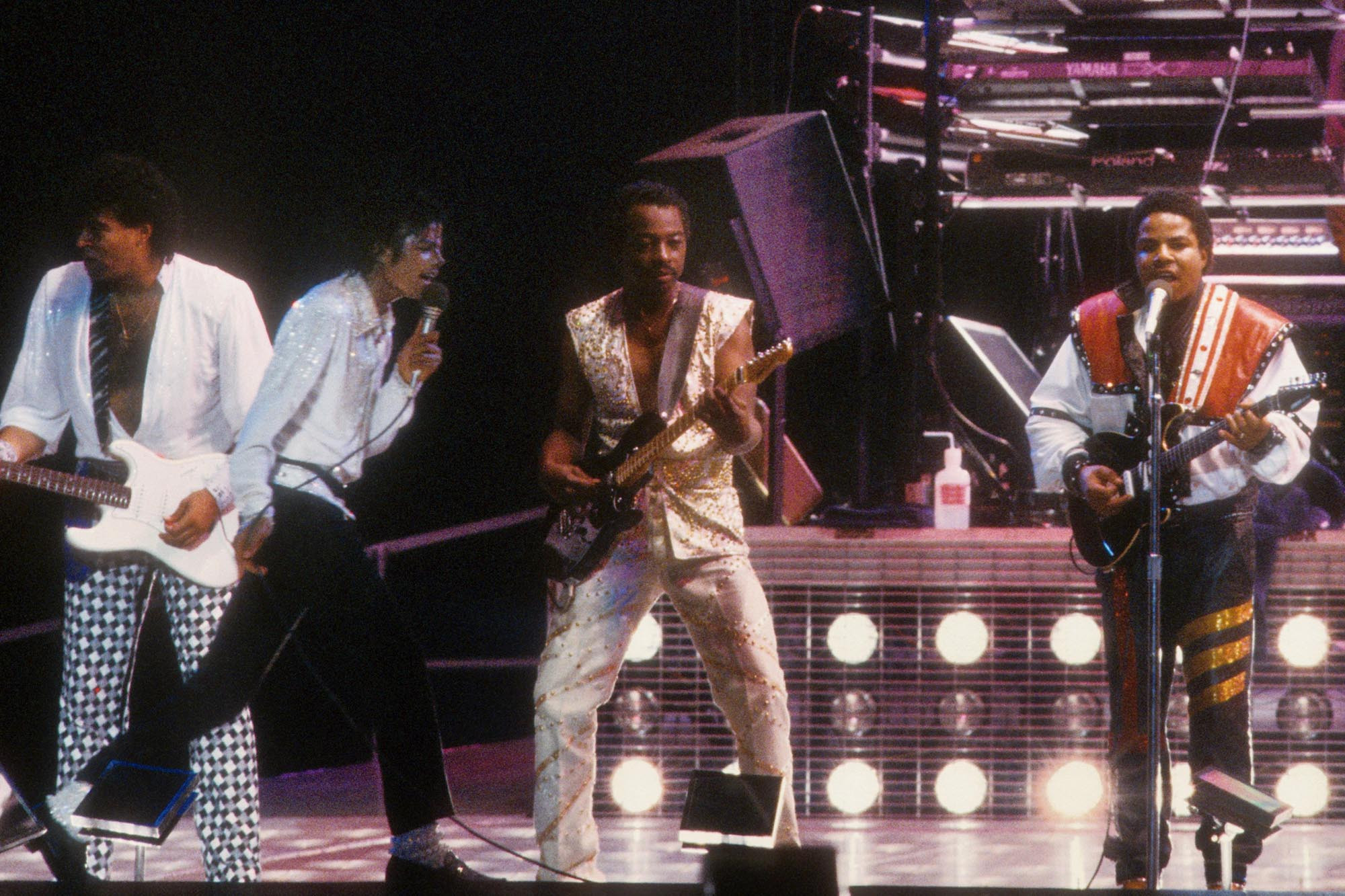 David Williams of The Jacksons performing onstage in Kansas City in 1984, playing guitar and showcasing his intentionally spare style that defined the sound of Eighties pop hits.
David Williams of The Jacksons performing onstage in Kansas City in 1984, playing guitar and showcasing his intentionally spare style that defined the sound of Eighties pop hits.
Image Credit: Michael Ochs Archive/Getty Images
Despite his jazz-oriented musical upbringing, David Williams made his most significant contributions to a genre not typically known for instrumental virtuosity: Eighties pop. His intentionally minimalist guitar touches are integral to the rhythmic allure of Michael Jackson’s “Billie Jean,” Stevie Nicks’ “Stand Back,” and Diana Ross’ “Muscles.” A Vietnam veteran, Williams toured extensively with Jackson and Madonna and collaborated with a diverse array of artists from Chaka Khan to Kenny Loggins. He once described the “secret spice” he brought to Top 40 hits: “You don’t need much of it, but the right amount gets the job done.” Williams’ understated yet crucial guitar work shaped the sound of some of the most iconic pop songs of the 1980s. He passed away in 2009 at the age of 58.
Key Tracks: “Billie Jean,” “Dirty Diana”
Etta Baker: Piedmont Blues Pioneer
 Etta Baker, photographed by Timothy Duffy, showcasing her role as a Piedmont blues pioneer and her influence on Bob Dylan and Taj Mahal.
Etta Baker, photographed by Timothy Duffy, showcasing her role as a Piedmont blues pioneer and her influence on Bob Dylan and Taj Mahal.
Image Credit: Timothy Duffy
Etta Baker’s name is synonymous with Piedmont blues, a style characterized by its rolling, ragtime and folk-influenced guitar playing, originating along the East Coast in the early 20th century. Born into a multi-racial family in North Carolina in 1913 and raised in Virginia, Baker learned guitar from her father and frequently performed at dances with her family in her youth. Her instrumental compositions, such as “One Dime Blues,” featured on a 1956 anthology, had a seismic impact. Among those captivated by her playing were Bob Dylan and Taj Mahal, with Mahal later recording an album with Baker before her passing in 2006. Baker’s intricate fingerpicking style and her preservation of Piedmont blues traditions have secured her legacy as a vital figure in American music history.
Key Tracks: “One Dime Blues,” “Carolina Breakdown”
Gustavo Cerati: Latin Rock Icon and Guitar God
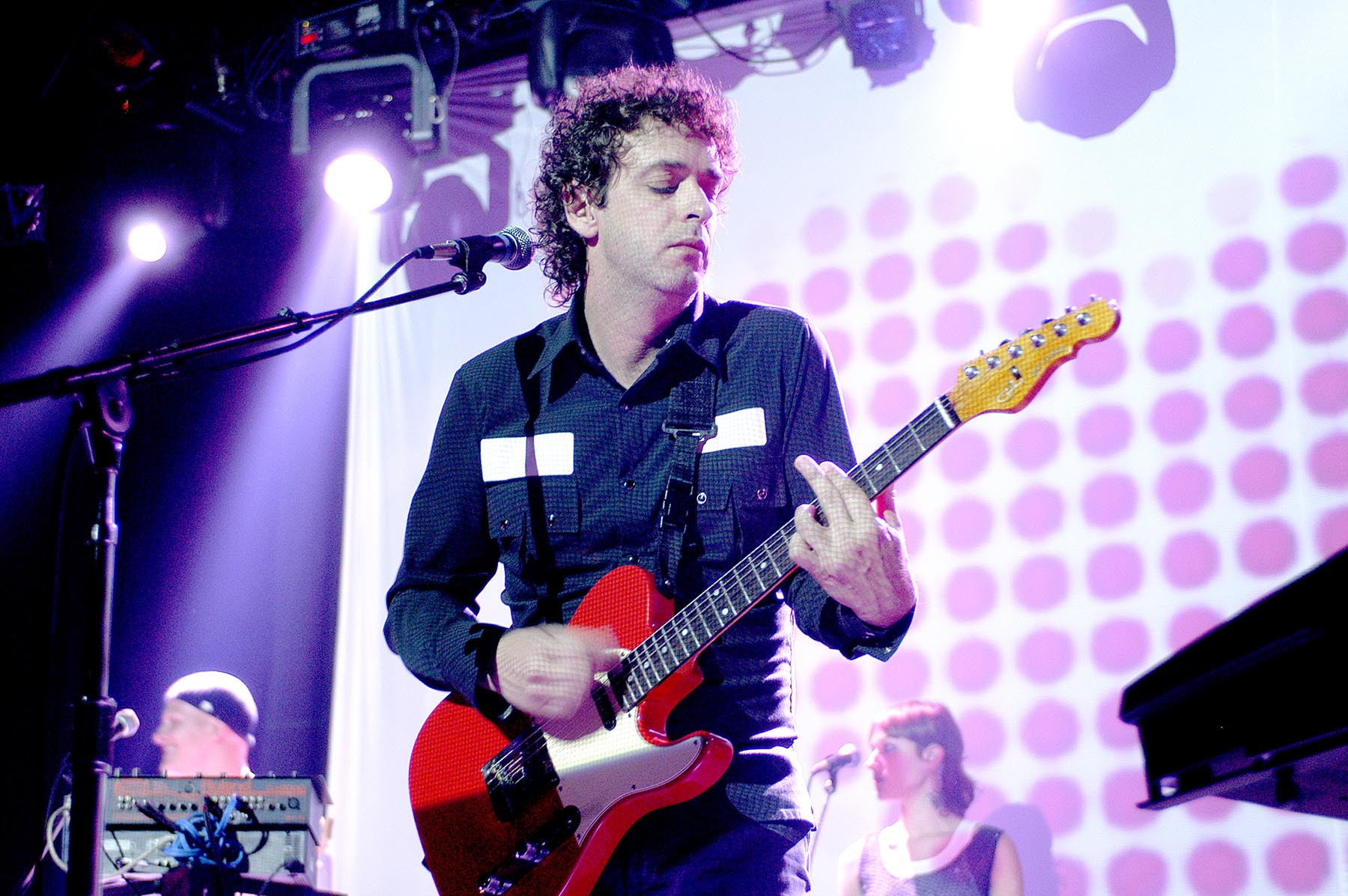 Gustavo Cerati performing onstage in Chicago in 2003, playing guitar and highlighting his role in transforming Latin rock and his guitar-god persona.
Gustavo Cerati performing onstage in Chicago in 2003, playing guitar and highlighting his role in transforming Latin rock and his guitar-god persona.
Image Credit: Paul Natkin/Getty Images
Perhaps due to his transformative impact on the sound of Latin rock through his majestic songwriting, Gustavo Cerati’s extraordinary guitar skills are sometimes overlooked. In the mid-Eighties, the Argentine singer-songwriter ignited a pan-American rock en español boom with his band Soda Stereo and anthemic hits like “De Música Ligera.” Following Soda Stereo’s disbandment, Cerati explored sequencers and samples, but he returned to his guitar-god persona with 2006’s Ahí Vamos, a powerful album saturated in raw electric riffs. Cerati tragically fell into a coma at age 50 and never recovered, but his image, smiling with evident joy while delivering a blistering guitar solo onstage, remains indelibly etched in the collective memory of Latin music culture. His guitar work was central to his artistic identity and his lasting influence.
Key Tracks: “Canción Animal,” “La Excepción”
Barbara Lynn: Soulful Blues Pioneer and Left-Handed Guitarist
 Barbara Lynn posing for a portrait circa 1964, playing a right-handed guitar left-handed and highlighting her soulful R&B sound and influence on The Rolling Stones.
Barbara Lynn posing for a portrait circa 1964, playing a right-handed guitar left-handed and highlighting her soulful R&B sound and influence on The Rolling Stones.
Image Credit: Michael Ochs Archives/Getty Images
Sixteen-year-old Barbara Lynn issued a firm warning to her boyfriend, Stank: “If you should lose me/You’ll lose a good thing.” The Beaufort, Texas native set these words to music, using a right-handed guitar she taught herself to play left-handed. The resulting song, “You’ll Lose a Good Thing,” topped the R&B charts in 1962, marking the first note in a celebrated six-decade career. Lynn’s predominantly self-penned songs have been covered by musical giants such as the Rolling Stones, Aretha Franklin, Otis Redding, and Robert Plant, and sampled by the Beastie Boys and Moby. This speaks to the universal appeal and creative force of her music, rooted in themes of heartbreak and resilience. Her left-handed guitar playing and soulful vocals established her as a significant figure in R&B and blues.
Key Tracks: “You’ll Lose a Good Thing,” “I’ll Suffer”
Steve Jones: Sex Pistols’ Architect of Punk Chaos
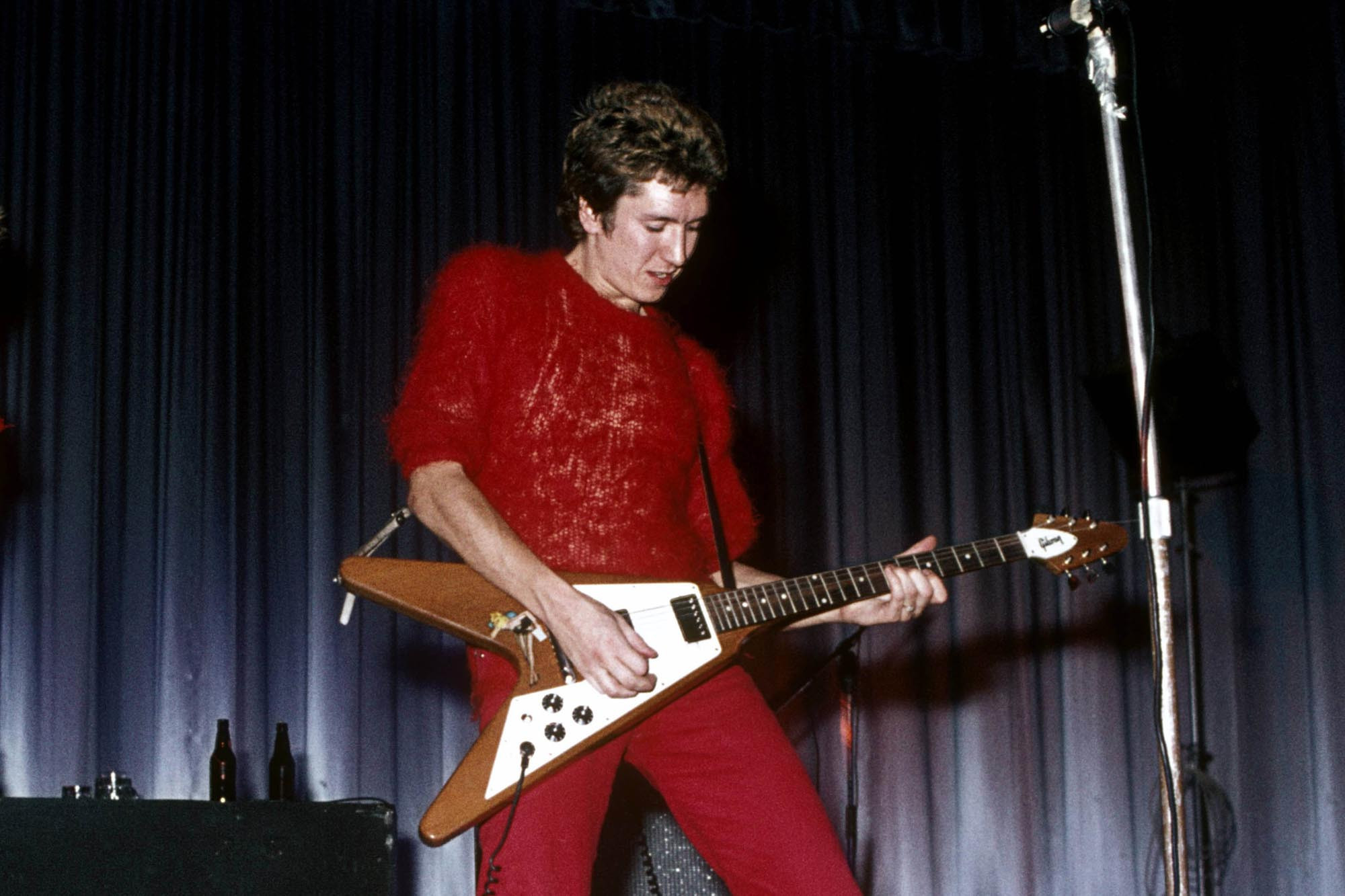 Steve Jones of the Sex Pistols performing live in Dunstable, UK, playing a Gibson Flying V guitar and showcasing his brutish power chords and flamboyant gutter-glam solos in punk rock.
Steve Jones of the Sex Pistols performing live in Dunstable, UK, playing a Gibson Flying V guitar and showcasing his brutish power chords and flamboyant gutter-glam solos in punk rock.
Image Credit: Chris Morphet/Redferns/Getty Images
When Malcolm McLaren, manager of the New York Dolls and later the Sex Pistols, gifted Steve Jones a white Les Paul Custom previously played by the Dolls’ Syl Sylvain, this instrument (or a similar model) became Jones’ signature weapon. Jones’ raw power chords and flamboyant, gutter-glam-influenced solos perfectly mirrored the taunting aggression of Johnny Rotten’s vocals, setting a new standard for punk rock guitarists. His legacy was cemented with the indelible riffs on the Sex Pistols’ 1977 album Never Mind the Bollocks…, an album that inspired guitarists from Slash to Billie Joe Armstrong. It was an attitude as much as a sound. As Jones famously told a journalist during the Sex Pistols era, “Actually, we’re not into music. We’re into chaos.” His chaotic and powerful guitar style defined the sound of punk rock.
Key Tracks: “God Save the Queen,” “Pretty Vacant”
Glenn Branca: No Wave Symphony of Guitars
 Glenn Branca, photographed at d-lab2/3 der AgfaPhoto GmbH, highlighting his role in New York's No Wave movement and his symphonic guitar compositions.
Glenn Branca, photographed at d-lab2/3 der AgfaPhoto GmbH, highlighting his role in New York's No Wave movement and his symphonic guitar compositions.
Image Credit: Hallwalls Archive/CC BY 3.0
A central figure in New York’s post-punk No Wave movement, Glenn Branca dedicated himself to establishing the guitar—often tuned to his custom “harmonic series” and modified to achieve diverse registers and timbres—as a symphonic instrument. He composed for ensembles that sometimes swelled to 100 guitarists. His droning, monumental Symphony No. 1, recorded in 1981, featured both Thurston Moore and Lee Ranaldo of Sonic Youth in the orchestra. Branca also released Sonic Youth’s debut album on his Neutral label, demonstrating his talent for recognizing and nurturing musical revolutionaries. “I’ve got so many ideas about music that I haven’t even begun to work on,” he stated in a 2016 Esquire interview. “If I lived to 200, I wouldn’t finish my work.” Branca’s experimental and symphonic approach expanded the possibilities of guitar music.
Key Tracks: “Light Field (In Consonance),” “Velvets and Pearls”
El Kempner: Palehound’s Versatile Indie Powerhouse
 El Kempner of Palehound performing at Boston Calling Music Festival in 2016, playing guitar and showcasing their versatile skills from indie rock riffs to acoustic fingerpicking.
El Kempner of Palehound performing at Boston Calling Music Festival in 2016, playing guitar and showcasing their versatile skills from indie rock riffs to acoustic fingerpicking.
Image Credit: Craig F. Walker/The Boston Globe/Getty Images
Long before El Kempner launched Palehound—an indie-powerhouse project that has recently toured with boygenius—they were a seven-year-old learning to play guitar by strumming their father’s instrument with a marker cap. Guitar has been Kempner’s guiding light ever since. Electrifying riffs, elevated by Kempner’s musical dexterity, drive dynamic tracks like “The Clutch” from Palehound’s recent album, Eye on the Bat. Kempner’s refined skills are matched by their versatility, equally comfortable rocking out on their beloved Stratocaster, performing delicate acoustic fingerpicking, or creating swirling arpeggios. Their dynamic and adaptable guitar playing is a defining characteristic of Palehound’s sound.
Key Tracks: “The Clutch,” “Independence Day”
Fred ‘Sonic’ Smith and Wayne Kramer: MC5’s Detroit Rock Engine
Image Credit: Leni Sinclair/Michael Ochs Archive/Getty Images
Forged in Detroit during the 1960s, the MC5 guitar duo of Wayne Kramer and Fred “Sonic” Smith functioned as the pistons of a high-performance engine. Blending Chuck Berry and early Motown influences with an emerging interest in free jazz, the pair could propel their band’s legendary high-energy jams into expansive sonic territories while maintaining a solid rhythmic foundation. “If you play with another guitar player long enough, you exhaust everything you know, and then you start playing what you don’t know, and you get into something good,” Kramer told Premier Guitar in 2018. “We just found that we could play syncopated rhythm parts simultaneously, and they would lock in perfectly, or we could solo simultaneously and they’d still lock in.” Their synchronized and improvisational guitar interplay was central to MC5’s revolutionary sound.
Key Tracks: “Looking at You,” “Poison”
Marv Tarplin: Smokey Robinson and The Miracles’ Secret Weapon
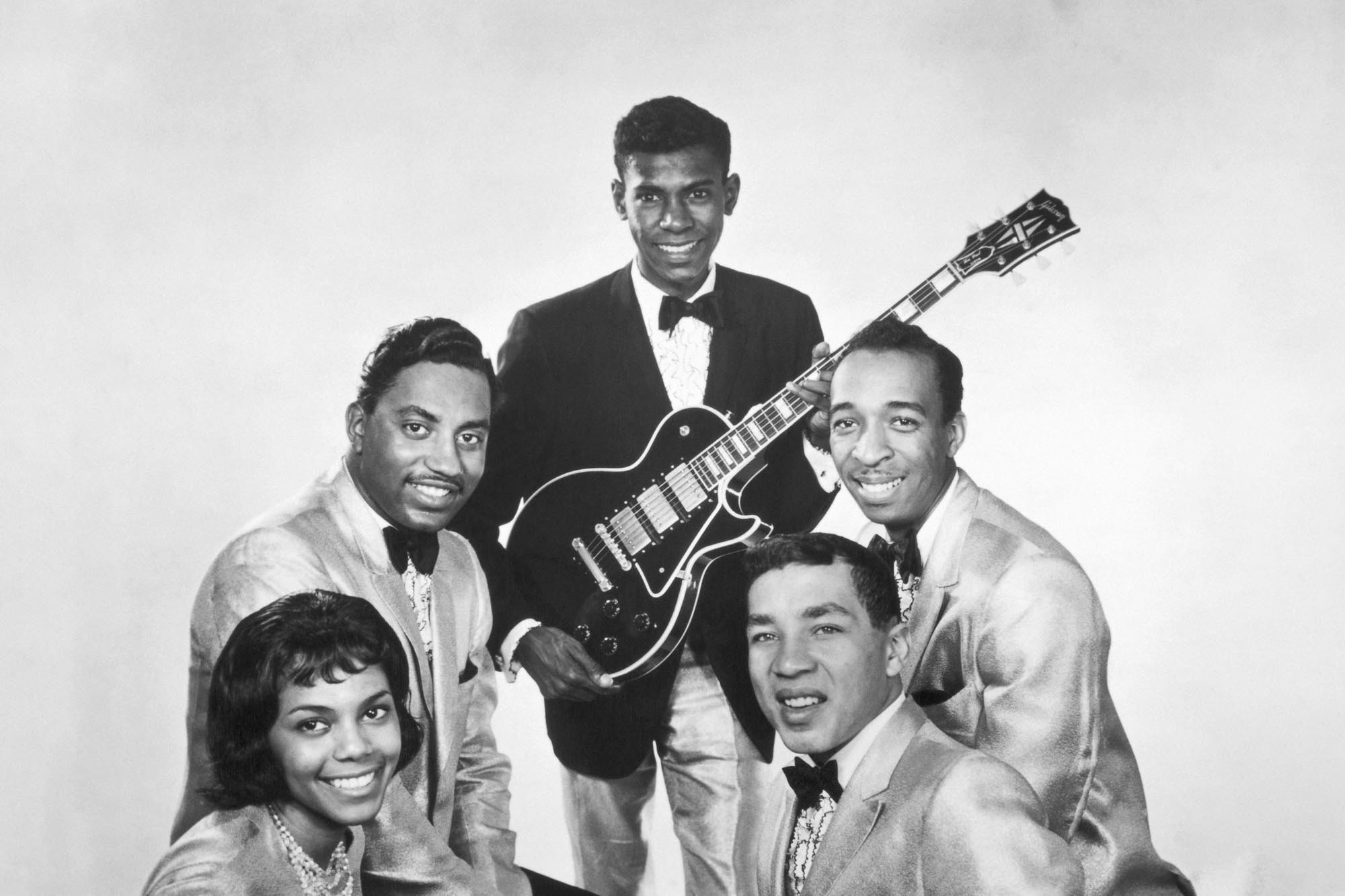 Marv Tarplin of Smokey Robinson and The Miracles posing for a portrait circa 1962, playing guitar and highlighting his key role in the band's success and Motown sound.
Marv Tarplin of Smokey Robinson and The Miracles posing for a portrait circa 1962, playing guitar and highlighting his key role in the band's success and Motown sound.
Image Credit: Michael Ochs Archives/Getty Images
The guitar playing and songwriting of Atlanta-born and Detroit-raised Marv Tarplin became essential to the success of Smokey Robinson and the Miracles almost immediately after Robinson handpicked him as the group’s guitarist in the 1960s. Tarplin’s versatility perfectly suited the demands of Motown, from his driving chords on “Going to a Go-Go” to the delicate 12-string acoustic work on “You Really Got a Hold on Me.” His experimentation with the chords of Harry Belafonte’s “Day-O (The Banana Boat Song)” led to the creation of the core melody for the Miracles’ smash hit “The Tracks of My Tears.” He continued his collaboration with Robinson after the Miracles disbanded; the delicate filigree guitar lines he added to Robinson’s 1979 solo single “Cruisin’” imbued the track with a timeless quality that propelled it into the Billboard Hot 100’s Top Five. Tarplin’s melodic and versatile guitar work was a cornerstone of the Motown sound.
Key Tracks: “The Tracks of My Tears,” “Cruisin’”
Joseph Spence: Bahamian Guitar Visionary
Image Credit: Guy Droussart
In 1958, musicologists Sam Charters and Ann Danberg Charters traveled to the Bahamas in search of musicians to record when they encountered Joseph Spence. His music was so rich and complex that from a distance, they believed they were listening to two guitarists. “He often seemed to be improvising in the bass, the middle strings, and the treble at the same time,” Sam Charters noted in the liner notes to Joseph Spence: The Complete Folkways Recordings 1958. Spence’s pointillistic, sharply angled fingerpicking, applied to a wide range of musical forms from blues to spirituals to calypso, profoundly influenced the folk movement and beyond. The Grateful Dead transformed Spence’s “We Bid You Goodnight” into a live set-closer, and the Beach Boys’ Pet Sounds classic “Sloop John B” is indebted to Spence’s version of the song. Spence’s innovative and polyrhythmic guitar style was a significant influence on folk and popular music.
Key Tracks: “Brownskin Girl,” “Jump in the Line”
Molly Tuttle: Bluegrass Innovator and Grammy Nominee
 Molly Tuttle performing at The Roxy Theatre in West Hollywood in 2014, playing acoustic guitar and showcasing her innovative bluegrass style and flatpicking virtuosity.
Molly Tuttle performing at The Roxy Theatre in West Hollywood in 2014, playing acoustic guitar and showcasing her innovative bluegrass style and flatpicking virtuosity.
Image Credit: Scott Dudelson/Getty Images
Even before receiving widespread accolades, California-raised, Nashville-based bluegrass innovator Molly Tuttle and her band Golden Highway were making their mark on roots music history. Her acoustic flatpicking style, influenced by figures ranging from Tony Rice to Joni Mitchell to Clarence White, is deeply rooted in tradition yet unbound by it. Earlier this year, Tuttle became the first bluegrass act to receive a Best New Artist Grammy nomination, signaling the genre’s continued evolution, in which Tuttle has played a significant role. “Our generation of bluegrass players are really pushing in some new directions,” Tuttle told Rolling Stone in January. “I feel lucky to be part of this scene that’s breaking down barriers.” Tuttle’s innovative approach and virtuosic playing are pushing bluegrass music into new territories.
Key Tracks: ‘Take the Journey,” “El Dorado”
James Blood Ulmer: Blues, Funk, and Free Jazz Fusion
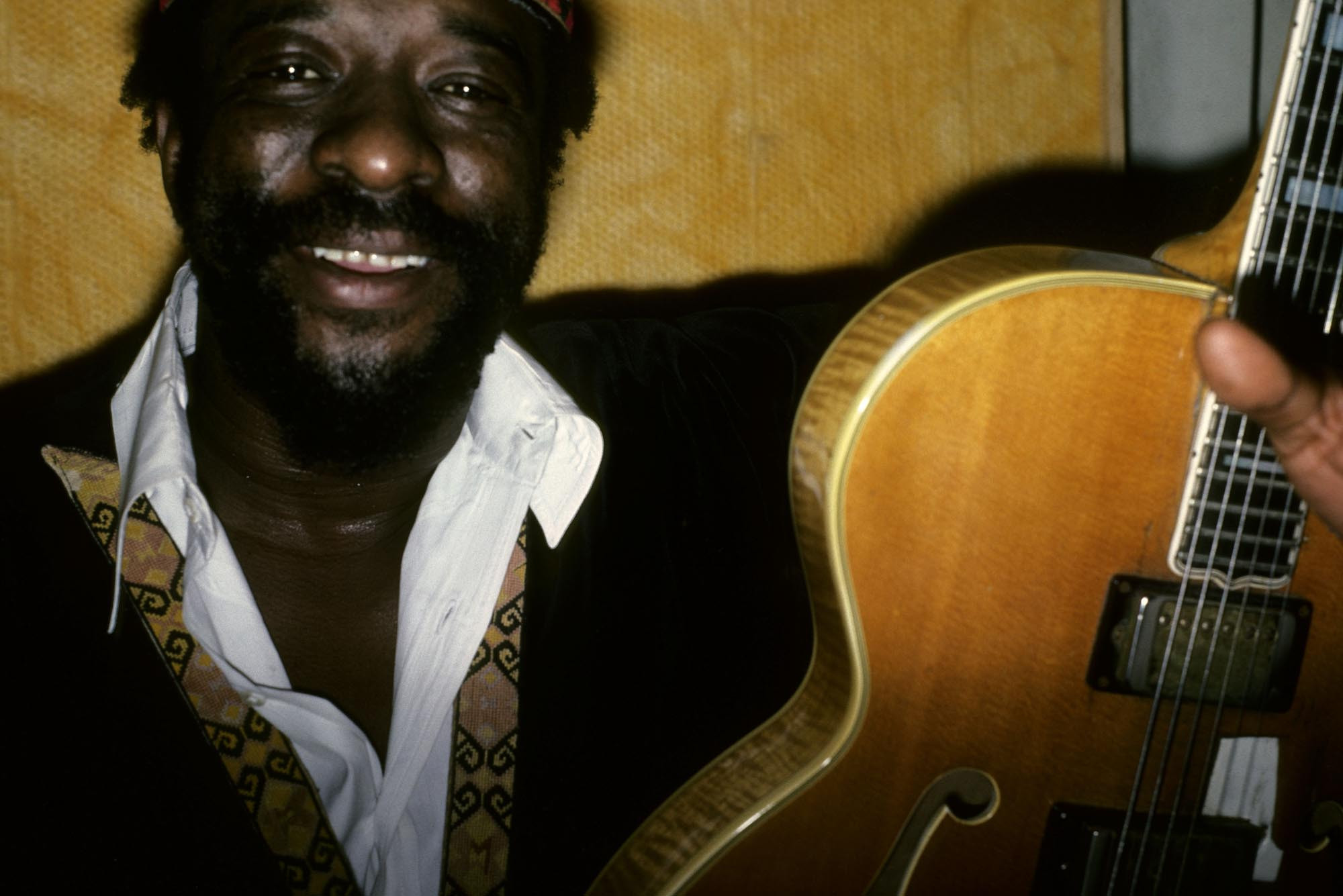 James Blood Ulmer, photographed by Peter Noble, highlighting his fusion of blues, funk, and free jazz guitar styles and his influence on Vernon Reid and the New York experimental scene.
James Blood Ulmer, photographed by Peter Noble, highlighting his fusion of blues, funk, and free jazz guitar styles and his influence on Vernon Reid and the New York experimental scene.
Image Credit: Peter Noble/Redferns/Getty Images
Initially playing soul jazz, and later serving as a dynamic counterpart to free jazz icon Ornette Coleman’s melodic explorations, James Blood Ulmer fused generations of blues, funk, and jazz guitar into shimmering sonic textures, skronky riffs, and jittery solos. Albums such as Tales of Captain Black and Odyssey showcased his stinging guitar tone, profoundly influencing the downtown New York experimental scene of the Seventies and Eighties, impacting artists from Vernon Reid (who produced Ulmer’s acclaimed 2000s blues albums) to no-wave bands like DNA and Mars. As Reid himself stated, “James Blood Ulmer is fully aware, theoretically and idiomatically — he’s just never been constrained by those concerns. He is a rock. He is unapologetically himself. He is the blues. Itself. Not its rules.” Ulmer’s genre-bending guitar style and uncompromising artistic vision have made him a highly influential figure.
Key Tracks: “Theme from Captain Black,” “Timeless”
Courtney Barnett: Intricate Indie Rock Storyteller
 Courtney Barnett, photographed for Rolling Stone, playing guitar and showcasing her ability to shift between intricate fingerpicking and frenetic garage-rock solos in her indie-rock songwriting.
Courtney Barnett, photographed for Rolling Stone, playing guitar and showcasing her ability to shift between intricate fingerpicking and frenetic garage-rock solos in her indie-rock songwriting.
Image Credit: Griffin Lotz for Rolling Stone
Indie-rock singer-songwriter Courtney Barnett’s ability to seamlessly transition between intricate, melodic fingerpicking and frenetic, garage-rock-inspired solos amplifies the dynamism of her witty storytelling. “It sounds like you’re driving across a highway and it’s sunny,” Barnett said to Rolling Stone in 2021, describing “Write a List of Things to Look Forward To” from her album Things Take Time, Take Time. This captures the essence of how Barnett’s guitar playing complements her lyrical and liberating songs. On Lotta Sea Lice, her 2017 collaboration album with Kurt Vile (also featured on this list), the musical chemistry between the two is palpable, with their guitars and vocals intertwining spontaneously and seamlessly. Barnett’s dynamic guitar work and narrative songwriting make her a standout voice in indie rock.
Key Tracks: “Turning Green,” “Over Everything,” “Pedestrian at Best”
Glenn Tipton and K.K. Downing: Judas Priest’s Heavy Metal Twin Attack
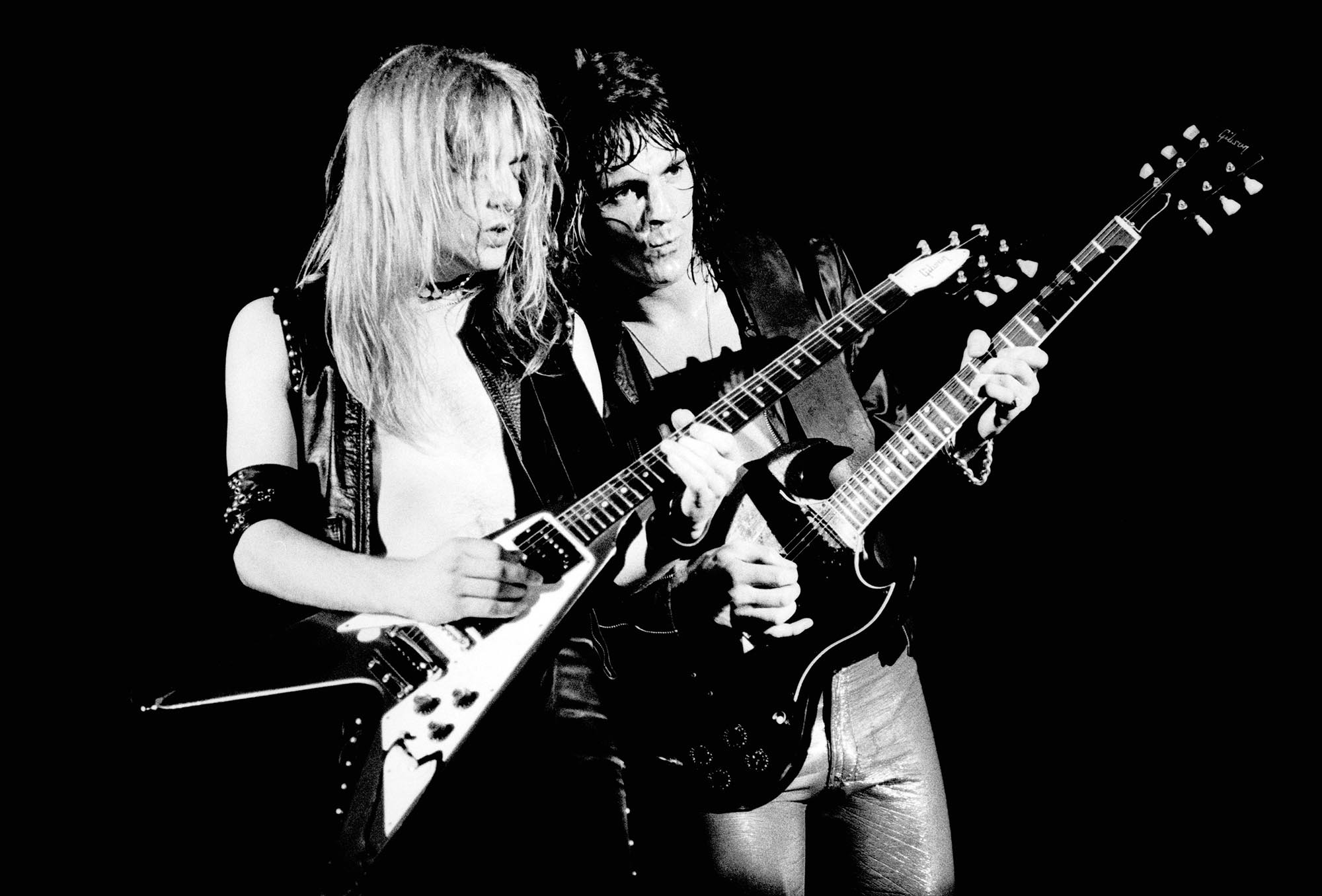 K.K. Downing and Glenn Tipton of Judas Priest performing onstage in London circa 1978, playing guitars and highlighting their twin-guitar harmony and their influence on heavy metal.
K.K. Downing and Glenn Tipton of Judas Priest performing onstage in London circa 1978, playing guitars and highlighting their twin-guitar harmony and their influence on heavy metal.
Image Credit: Gus Stewart/Redferns/Getty Images
Having witnessed the impact of single-guitarist bands like Black Sabbath, Led Zeppelin, and Deep Purple, Judas Priest redefined “heavy” in the mid-Seventies with a twin-guitar assault featuring K.K. Downing and Glenn Tipton. Instead of dividing roles into rhythm and lead guitar, as bands like the Rolling Stones and the Kinks had done, Tipton and Downing doubled down on riffs, alternated blistering solos, and embraced harmony leads on Judas Priest’s high-octane tracks. Their collaborative approach established the template for Iron Maiden, Metallica, Slayer, and countless subsequent two-guitar bands. As Slayer’s Kerry King has noted, “You can almost always tell that if it’s Tipton, it’s super-fucking tasty. If it’s K.K., it’s a more edgy, almost punky kind of vibe, which is a great mix.” Their twin-guitar synergy was instrumental in shaping the sound of heavy metal.
Key Tracks: “Victim of Changes,” “Breaking the Law,” “The Hellion/Electric Eye”
Lzzy Hale: Halestorm’s Hard Rock Goddess
 Lzzy Hale of Halestorm performing in Wheatland, CA, playing guitar and showcasing her powerful vocals and aggressive rhythmic guitar style in hard rock.
Lzzy Hale of Halestorm performing in Wheatland, CA, playing guitar and showcasing her powerful vocals and aggressive rhythmic guitar style in hard rock.
Image Credit: Tim Mosenfelder/Getty Images
Lzzy Hale’s powerhouse vocals alone would qualify her as a hard rock icon. However, she is also a fierce guitarist, employing an aggressively rhythmic slap style that complements Halestorm’s lead guitarist Joe Hottinger. Hale is also a proficient shredder, as demonstrated by her guitar mimicry of the vocal melody in “I Miss the Misery.” Her influence on 21st-century guitar rock is so significant that Gibson chose her as their first female brand ambassador. The company even created a Hale signature model Explorer guitar, which she plays onstage and gifts to fellow musicians, from Demi Lovato to Daniela Villarreal of the Warning. “The people at Gibson keep telling me the demographic that buys the most electric guitars right now are female,” Hale told Rolling Stone. “The wave is coming whether anybody likes it or not.” Hale’s commanding stage presence and guitar skills are inspiring a new generation of female guitarists in rock.
Key Tracks: “I Miss the Misery,” “The Steeple”
Thomas McClary: Commodores’ Funk and Soul Architect
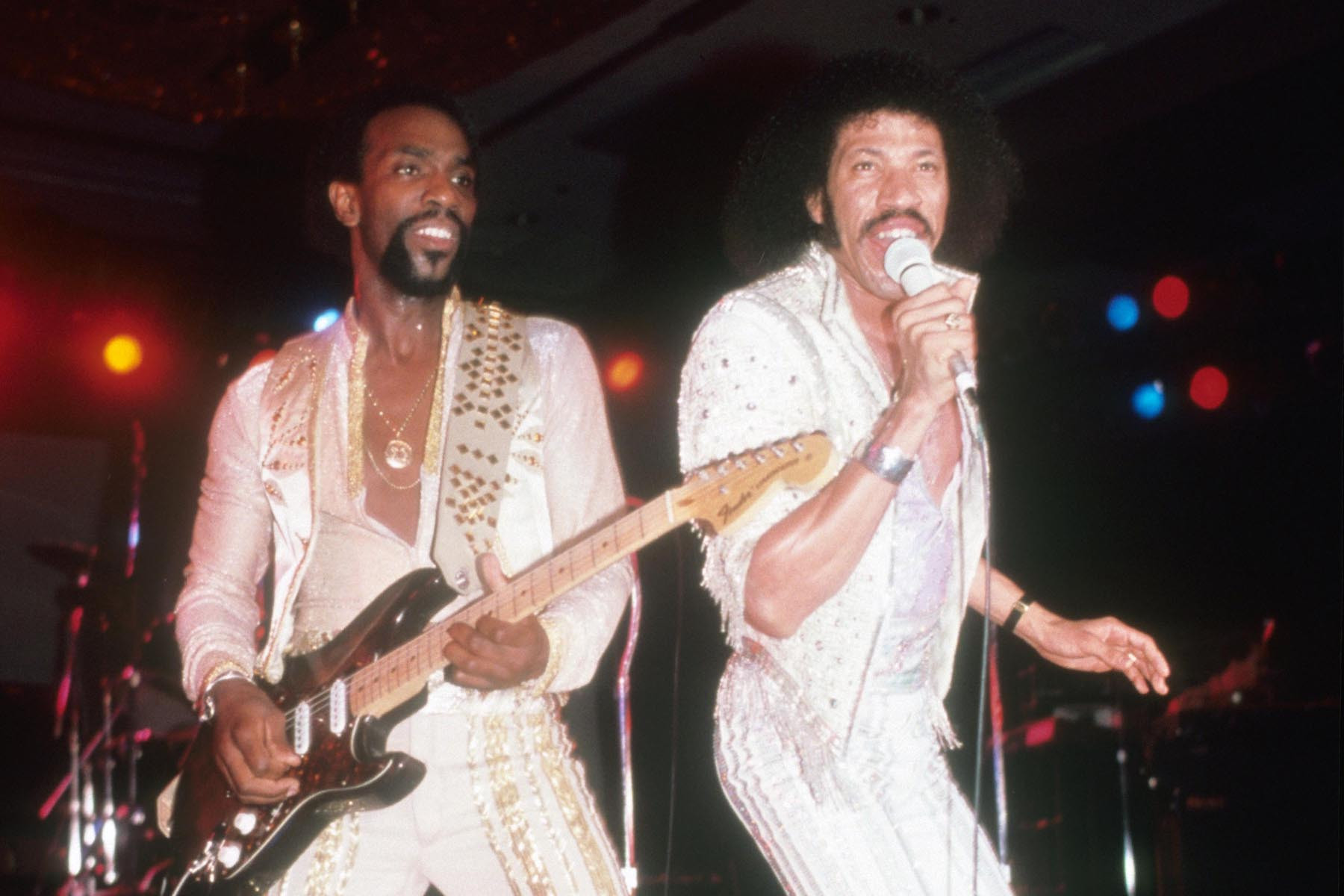 Thomas McClary of The Commodores with Lionel Richie in 1978, playing guitar and highlighting his role in shaping the band's funk, soul, and crossover sound.
Thomas McClary of The Commodores with Lionel Richie in 1978, playing guitar and highlighting his role in shaping the band's funk, soul, and crossover sound.
Image Credit: Alamy
As one of the first Black students to integrate Florida public schools, Eustis, Florida-born Thomas McClary, whose first instrument was the ukulele, was accustomed to forging his own path. He attended Tuskegee Institute in Alabama, where he co-founded the Commodores with singer Lionel Richie. The group fused funk, soul, gospel, and country in a way that appealed to both Black and white audiences, and McClary’s blend of glam grandeur and blues grit on songs like “Easy” helped define the sound of Eighties crossover music. “I would listen to Santana, Jimi Hendrix, Albert King, James Taylor, and Crosby, Stills, Nash, and Young,” he later recalled. “I thought it would be really great to mesh those guys together to have a really raunchy, raw, authentic sound that could be appealing to everybody.” McClary’s genre-blending guitar style was crucial to The Commodores’ broad appeal.
Key Tracks: “Easy,” “Brick House”
Steve Hackett: Genesis’ Prog Rock Innovator
Image Credit: Richard E. Aaron/Redferns/Getty Images
Genesis was a relatively obscure art-rock band before guitarist Steve Hackett joined in 1971, succeeding founding member Anthony Phillips. Hackett made an immediate impact by introducing the band to his two-hand tapping technique, which they utilized on 1971’s Nursery Crime, years before Eddie Van Halen popularized it. A few years later, he recorded an epic, soaring guitar solo on their masterpiece “Firth of Fifth,” one of the most celebrated guitar passages in prog-rock history. Hackett left Genesis in 1977 to pursue a solo career that continues to this day. “I’m very happy to have freed up guitarists to play dazzling solos,” Hackett reflected, “and come up with things that would only be dreamt up at one time.” His innovative techniques and melodic sensibilities were instrumental in shaping the sound of progressive rock.
Key Tracks: “Horizons,” “Firth of Fifth”
Kurt Vile: Slacker Dude with Virtuoso Guitar Skills
 Kurt Vile posing with a Fender Jaguar guitar in Amsterdam in 2015, highlighting his slacker persona and his intricate and melodic guitar style rooted in banjo influences.
Kurt Vile posing with a Fender Jaguar guitar in Amsterdam in 2015, highlighting his slacker persona and his intricate and melodic guitar style rooted in banjo influences.
Image Credit: Paul Bergen/Redferns/Getty Images
Kurt Vile often projects an easygoing slacker persona, but he is a seriously skilled guitarist. His style, which combines relaxed drones and intricate yet melodic solos, is partially rooted in his early experience with the banjo, which he received from his parents as a teenager after initially requesting a guitar. “Banjos are in an open tuning, and they’ve got that high drone string,” the Philadelphia-based musician told guitar.com in 2018. “It’s not like you’d even think about that when you’re playing as a kid, but I came to really like that ethereal drone.” Over his career, Vile has incorporated influences from across the musical spectrum, synthesizing them into his signature, subtly virtuosic style. His relaxed yet intricate guitar playing is a defining characteristic of his indie-rock sound.
Key Tracks: “Pretty Pimpin,” “Wakin on a Pretty Day”
Keiji Haino: Japanese Noise Guitar Exorcist
 Keiji Haino posing for a portrait in Tokyo, highlighting his free-form noise guitar performances and his cathartic and experimental approach to music.
Keiji Haino posing for a portrait in Tokyo, highlighting his free-form noise guitar performances and his cathartic and experimental approach to music.
Image Credit: Alamy
Japanese musician Keiji Haino’s free-form solo performances are intense, noisy exercises in catharsis. It is often unclear whether he is simply playing the guitar or performing an exorcism upon it. In ensemble settings, such as the late-Nineties group Aihiyo, whose self-titled debut is beautifully raw and deeply emotive, Haino’s range is evident. He can create soothing, shimmering chords one moment and assault the listener’s ears with squalls of fuzz the next. “People practice really hard because they want people to check them out,” he told Vice Japan. “And then they say it’s improvisation. That drives me nuts.” Haino’s extreme and improvisational guitar style is a unique and powerful force in experimental music.
Key Tracks: “A Shredded Coiled Cable Within This Cable Sincerity Could Not be Contained,” “Why in the Courtesy of the Prey Always Confused With the Courtesy of the Hunters Pt. 1”
Lucy Dacus: Understated Guitar Strength in Indie Rock
 Lucy Dacus, photographed for Rolling Stone, playing guitar and highlighting her understated but essential guitar arrangements in her indie-rock songwriting and performances.
Lucy Dacus, photographed for Rolling Stone, playing guitar and highlighting her understated but essential guitar arrangements in her indie-rock songwriting and performances.
Image Credit: Griffin Lotz for Rolling Stone
For Lucy Dacus, the guitar is as fundamental to her musical expression as her voice, even if her playing often receives less attention than her poignant lyrics. From her driving rhythm guitar part on the standout track “I Don’t Wanna Be Funny Anymore” to her contributions in the indie supergroup boygenius, Dacus’ guitar arrangements are an understated but crucial element of her artistry. Live performances of her fan-favorite song “Night Shift” begin quietly, with Dacus strumming alone. Her longtime lead guitarist Jacob Blizard introduces distorted textures as the song progresses, but Dacus remains locked in beside him throughout the song’s dynamic shifts, never losing intensity. By the song’s cathartic conclusion, Dacus’s final farewell to a past love is powerfully conveyed, underscored by her unwavering guitar presence. Her guitar work provides a solid and emotional foundation for her introspective songwriting.
Key Tracks: “Night Shift,” “I Don’t Wanna Be Funny Anymore”
José Feliciano: Blind Virtuoso and Genre-Bending Pioneer
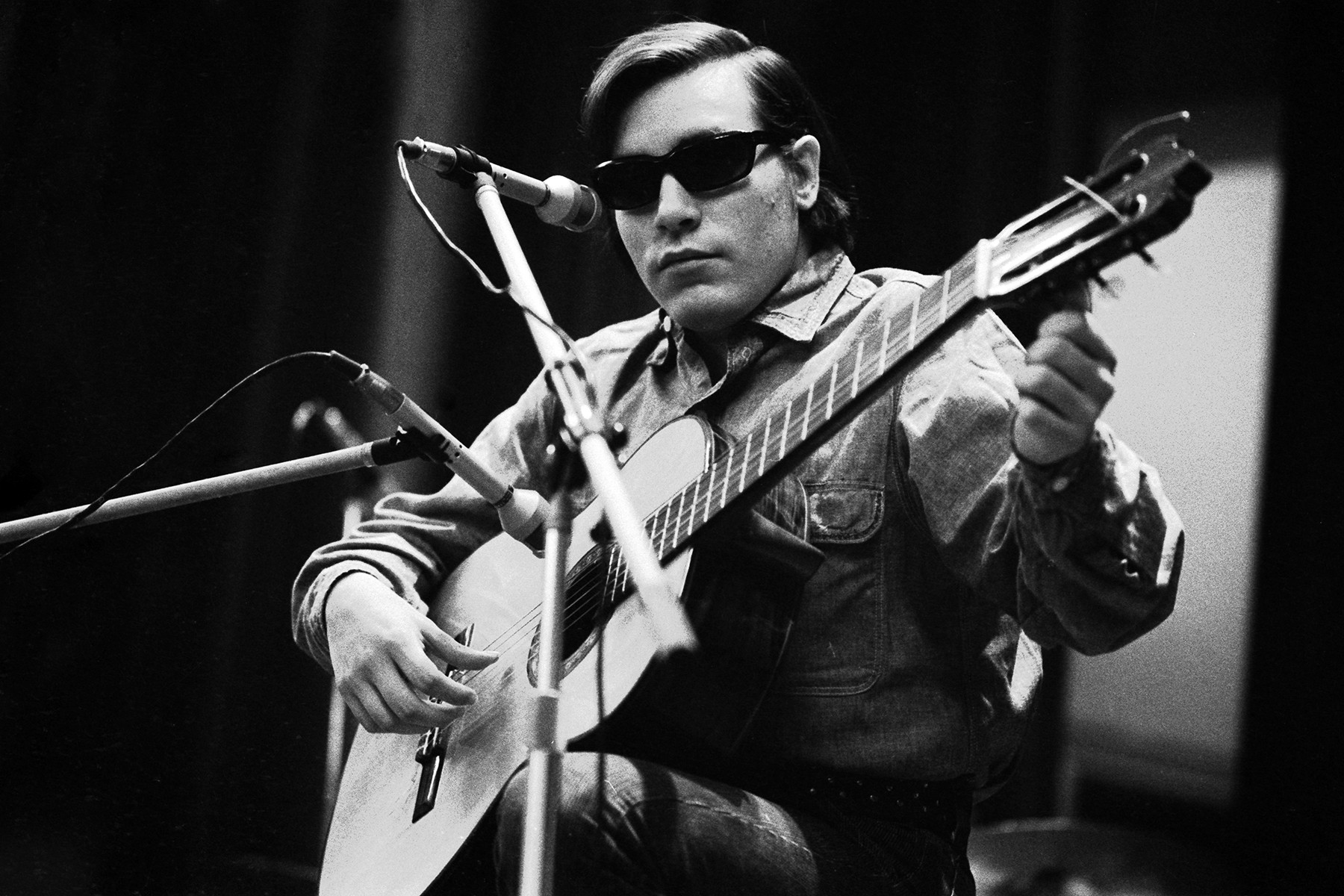 José Feliciano performing at the Royal Albert Hall in London in 1973, playing guitar and highlighting his virtuosity, his Latin heritage, and his genre-bending approach to pop rock.
José Feliciano performing at the Royal Albert Hall in London in 1973, playing guitar and highlighting his virtuosity, his Latin heritage, and his genre-bending approach to pop rock.
Image Credit: Evening Standard/Hulton Archive/Getty Images
To think of José Feliciano solely as the voice behind “Feliz Navidad” would be a profound disservice to his musical breadth. Born blind, Feliciano became an acoustic guitar virtuoso in his teens. His playing, alternating between lyrical beauty and fiery intensity, is deeply informed by the boleros and folk songs of his Puerto Rican heritage. His eclectic fusion of styles—rock, jazz, soul, bossa nova—transformed the sound of mainstream pop rock in the Sixties. Feliciano’s radical 1968 reimagining of the Mamas and the Papas’ “California Dreamin’” featured him vocalizing in Spanish like a salsa sonero, and his pyrotechnic guitar rendition of “Light My Fire” propelled The Doors classic into darker, more cinematic realms. Feliciano’s virtuosity and genre-crossing innovation established him as a significant figure in popular music.
Key Tracks: “Light My Fire,” “Here, There and Everywhere”
Nick Zinner: Yeah Yeah Yeahs’ Glittering Garage Punk
 Nick Zinner of Yeah Yeah Yeahs, photographed for Rolling Stone, playing guitar and highlighting his signature catchy and glittering riffs in dance-punk and garage rock.
Nick Zinner of Yeah Yeah Yeahs, photographed for Rolling Stone, playing guitar and highlighting his signature catchy and glittering riffs in dance-punk and garage rock.
Image Credit: Sacha Lecca for Rolling Stone
When New York City’s garage-rock trio Yeah Yeah Yeahs formed in 2000, their aim was to create something “trashy, punky, grimy.” Nick Zinner’s guitar style embodies these qualities and more, blending the dance-punk energy of ESG, the showmanship of Van Halen, the raw intensity of Rowland S. Howard, and the melodic sensibility of Johnny Marr into his signature catchy, glittering riffs. Zinner’s guitar work is often minimalist yet conveys profound emotion, from the yearning in “Maps” to the monstrous tension of “Heads Will Roll.” His distinctive guitar sound is integral to Yeah Yeah Yeahs’ iconic status in garage and dance-punk genres.
Key Tracks: “Y Control,” “Maps,” “Gold Lion”
Kaki King: Acoustic Guitar Sonic Adventurer
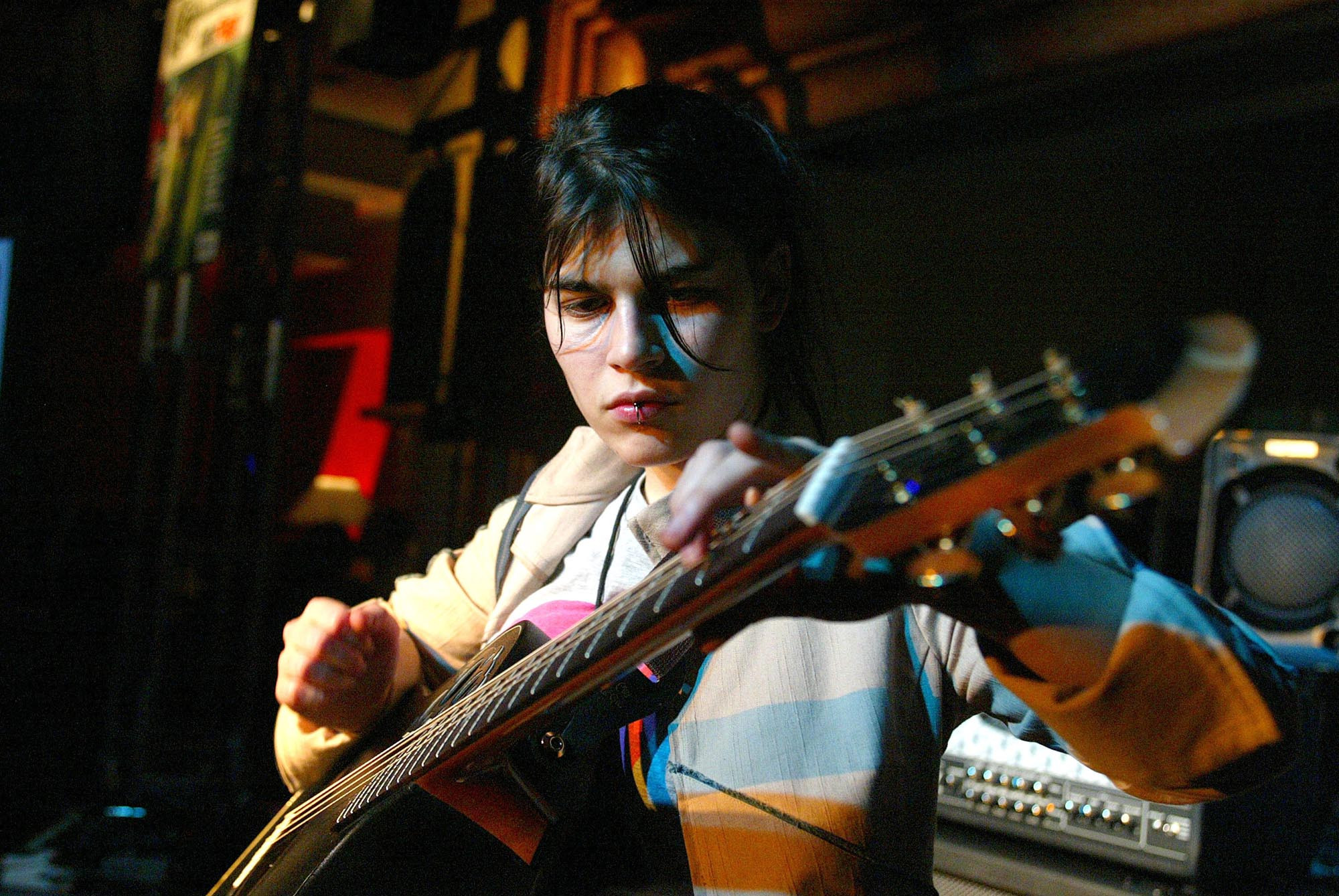 Kaki King, photographed by Jeffrey Mayer, playing acoustic guitar and highlighting her experimental techniques, alternate tunings, and percussive playing style.
Kaki King, photographed by Jeffrey Mayer, playing acoustic guitar and highlighting her experimental techniques, alternate tunings, and percussive playing style.
Image Credit: Jeffrey Mayer/WireImage
Kaki King, a tireless sonic explorer, adopts a Preston Reed-meets-John Cage approach to the acoustic guitar. She experiments with alternate tunings, “treated” instruments, and electronic loops, while employing fingerstyle techniques, two-handed tapping, and percussive slapping. “I’ll think, ‘Let’s see what happens if I lower this string here and raise that one there,’” she told Premier Guitar in 2011. “When you tune your guitar differently, all of a sudden your fingers and your mind have to be creative again because you’re not relying on shapes and places that sound good or feel familiar. You have to explore the fretboard to find new fingerings and sounds, and that leads to new discoveries.” King’s experimental and innovative approach pushes the boundaries of acoustic guitar music.
Key Tracks: “Playing With Pink Noise,” “Skimming the Fractured Surface to a Place of Endless Light”
Gary Clark Jr.: Blues Rock Firebrand and Genre Blender
 Gary Clark Jr., photographed for Guitarist Magazine, playing guitar and highlighting his blues-rock firebrand style and his genre-blending approach incorporating soul, funk, and hip-hop.
Gary Clark Jr., photographed for Guitarist Magazine, playing guitar and highlighting his blues-rock firebrand style and his genre-blending approach incorporating soul, funk, and hip-hop.
Image Credit: Rob Monk/Guitarist Magazine/Future/Getty Images
Initially categorized as an heir to Jimi Hendrix or Stevie Ray Vaughan, Grammy-winning blues-rock guitarist Gary Clark Jr. has consistently demonstrated a far broader musical scope in his fiery playing. He incorporates elements of soul, funk, grunge, and hip-hop into his recordings and collaborations with diverse artists like Foo Fighters, Alicia Keys, Tech N9ne, and Bun B. “I don’t think that I’m reaching my full potential if I just do what people expect of me,” he told Rolling Stone in 2014. “I love to play, and I love to experiment, and there are a lot more roads to explore. I don’t know if I want to get too far off the path — I don’t want to get lost in the forest — but I like to wander out a bit and adventure.” Clark Jr.’s genre-defying approach and virtuosic guitar skills have positioned him as a leading figure in contemporary blues and rock.
Key Tracks: “This Land,” “Grinder”
Amadou Bagayoko: Malian Desert Blues Guitar Pioneer
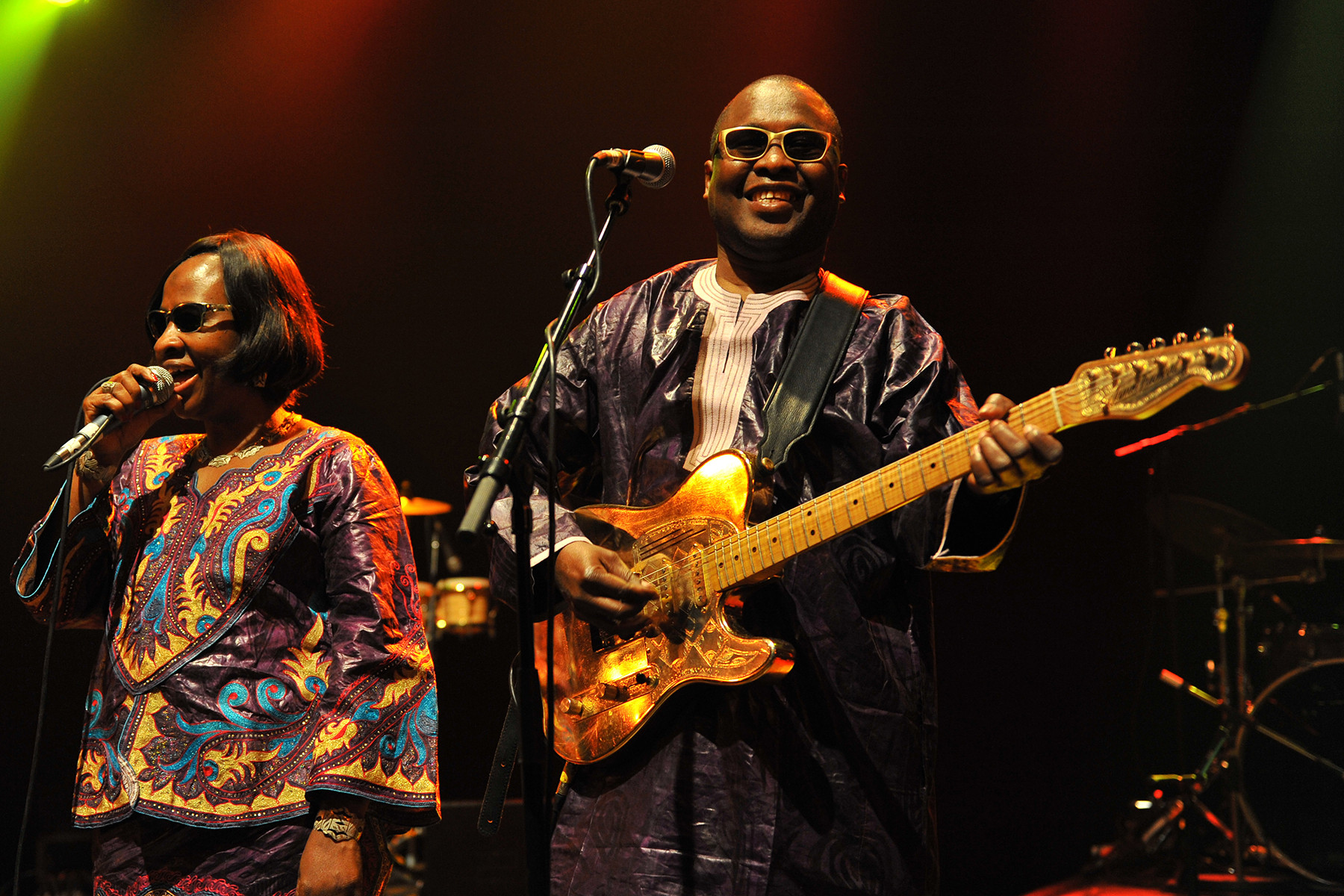 Amadou Bagayoko of Amadou & Mariam performing live in London in 2012, playing guitar and highlighting his Malian desert blues style and his blend of Western pop influences.
Amadou Bagayoko of Amadou & Mariam performing live in London in 2012, playing guitar and highlighting his Malian desert blues style and his blend of Western pop influences.
Image Credit: C Brandon/Redferns/Getty Images
Malian musicians Amadou Bagayoko and Mariam Doumbia, who met at an institute for the blind in 1977, achieved international recognition as Amadou & Mariam when their brightly melodic duets, rhythmically anchored by Amadou’s jaunty and occasionally skronky guitar leads, crossed over to the rock festival circuit. This crossover success is not surprising given their influences. “People are often surprised when we explain how much we were influenced by Western pop music,” Amadou Bagayoko once remarked with a laugh. “I grew up listening to records by Rod Stewart, Led Zeppelin, James Brown, Crosby, Stills, and Nash, Eric Clapton, Jeff Beck, Pink Floyd, Stevie Wonder … That’s because they were the only records we had in Mali!” Bagayoko’s blend of Malian musical traditions with Western rock and pop influences creates a unique and globally appealing guitar style.
Key Tracks: “Djanfa,” “Ce N’est Pas Bon”
Justin Broadrick: Industrial Metal Guitar Architect
 Justin Broadrick of Godflesh on set in New York, highlighting his industrial-metal guitar style and his pioneering work in grindcore and post-metal genres.
Justin Broadrick of Godflesh on set in New York, highlighting his industrial-metal guitar style and his pioneering work in grindcore and post-metal genres.
Image Credit: Karjean Levine/Getty Images
Justin Broadrick has developed his own distinct guitar vocabulary across industrial-metal pioneers Godflesh, grindcore originators Napalm Death, and psychedelic post-metal project Jesu, among numerous other ventures. His steamrolling, elastic riffs and dense textures in Godflesh infused a rare human element into the band’s mechanical rhythms. In Napalm Death, he contributed to pioneering the “grinding” sound of grindcore—hyper-fast death metal—by pushing his distortion to extreme levels, emphasizing sonic texture over clear notes on tracks like “Instinct of Survival.” In Jesu, his psychedelic post-metal guise, he layered dense washes of noise to create immersive sonic worlds that enveloped his vocals. In all his projects, Broadrick’s guitar sound is distinctive and emotionally resonant, characterized by its sighs, groans, and weeping textures. His innovative approach to distortion and sonic layering has been highly influential in metal and experimental music.
Key Tracks: “Like Rats,” “Silver,” “Scum”
Hugh McCracken: Session Guitarist of Countless Classics
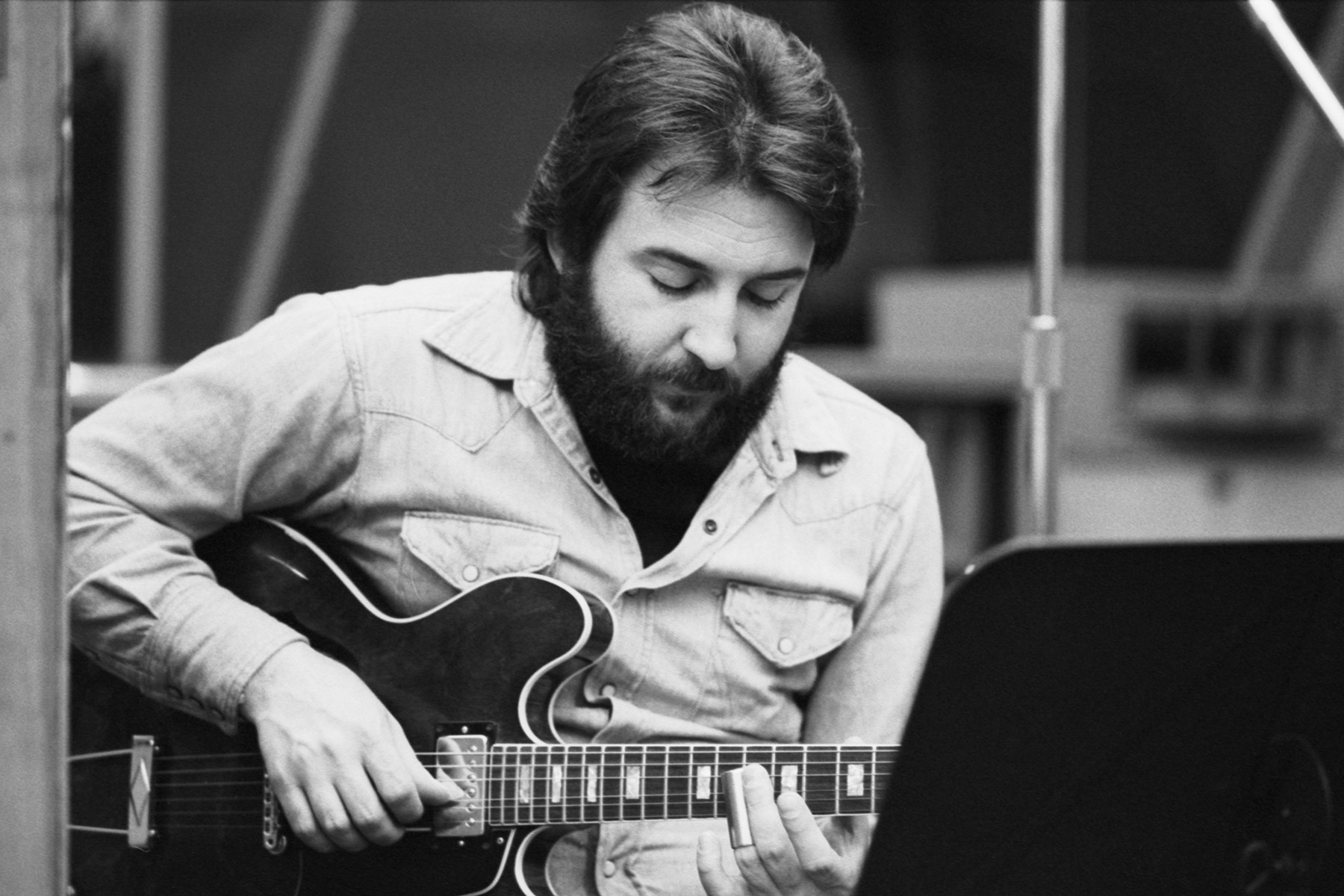 Hugh McCracken during a recording session for Aretha Franklin at Atlantic Records, highlighting his tasteful and essential session guitar work on countless classic songs.
Hugh McCracken during a recording session for Aretha Franklin at Atlantic Records, highlighting his tasteful and essential session guitar work on countless classic songs.
Image Credit: David Gahr/Getty Images
East Coast guitarist Hugh McCracken was never a showy soloist, but his tasteful and essential guitar work is present on countless classic recordings. His piercing lead guitar lines define Steely Dan’s “Hey Nineteen,” his energetic opening lick drives Van Morrison’s “Brown Eyed Girl,” and his smooth acoustic guitar textures enrich Roberta Flack’s “Killing Me Softly With His Song.” In an understated yet vital manner, he also enhanced Paul Simon’s “50 Ways to Leave Your Lover,” Alicia Keys’ “If I Ain’t Got You,” and John Lennon and Yoko Ono’s “I’m Losing You.” McCracken was in such high demand and so content with studio work that he declined Paul McCartney’s offer to join Wings after playing on Ram. His versatility and tasteful playing made him one of the most sought-after session guitarists of his era.
Key Tracks: “Hey Nineteen,” “Killing Me Softly With His Song”
Eric Johnson: Guitar Technician’s Guitarist
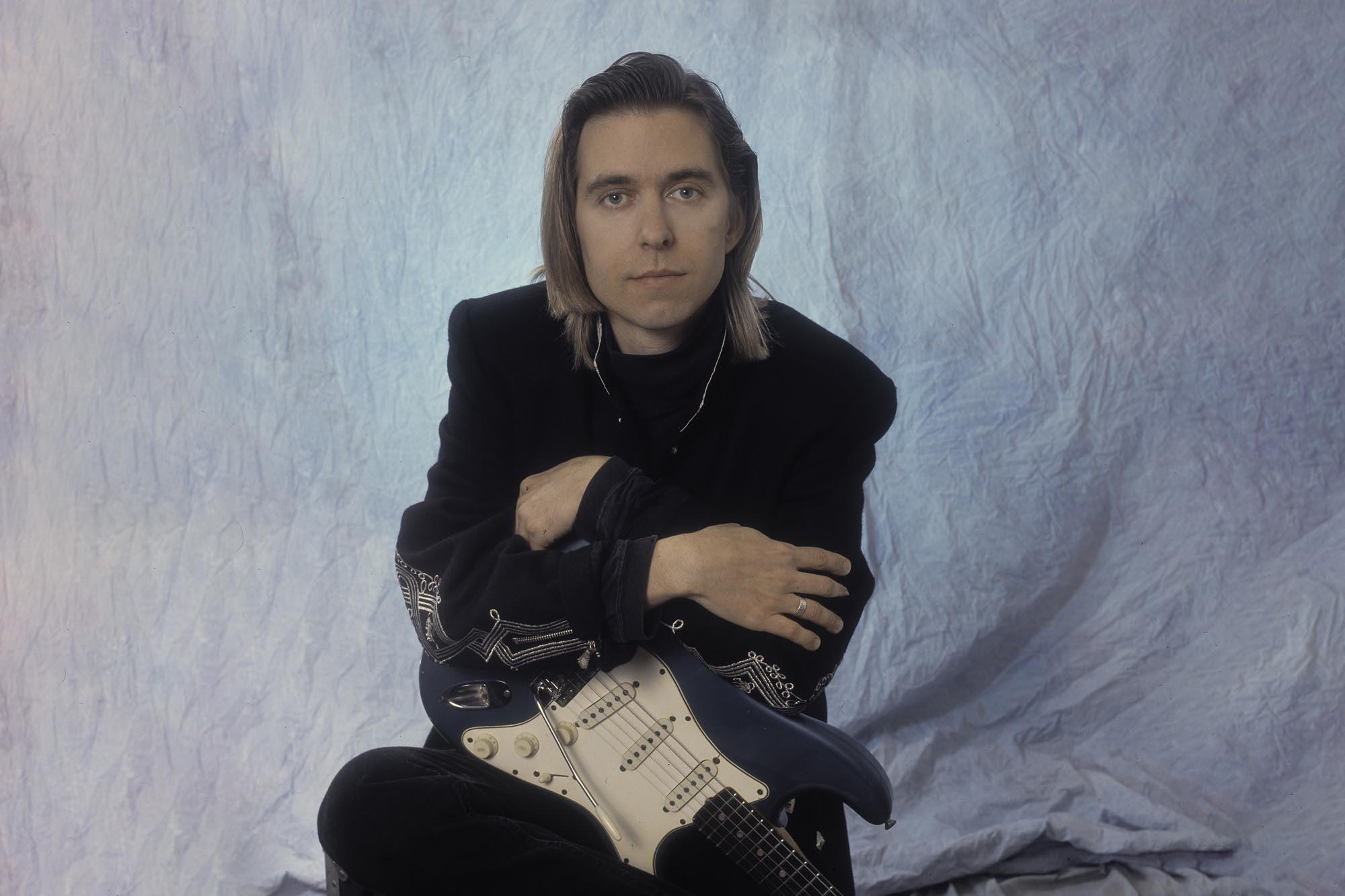 Eric Johnson posing for a portrait in Pittsburgh in 1991, highlighting his consummate guitar technique and his appreciation among fellow musicians like Steve Morse and Stevie Ray Vaughan.
Eric Johnson posing for a portrait in Pittsburgh in 1991, highlighting his consummate guitar technique and his appreciation among fellow musicians like Steve Morse and Stevie Ray Vaughan.
Image Credit: Paul Natkin/Getty Images
Austin-born Eric Johnson is a quintessential technician, a guitarist whose abilities are often more appreciated by his fellow musicians than the general public. “Eric’s so good it’s ridiculous,” Steve Morse raved, while Stevie Ray Vaughan considered him “one of my favorite guitarists.” “Damn, that guy can play!” was Billy Gibbons’ succinct assessment. A fusion stylist leaning more towards rock than jazz, Johnson was a rising star in the mid-Seventies Austin music scene but experienced career setbacks due to contractual disputes. Although his 1990 instrumental album Ah Via Musicom eventually achieved platinum status, he is primarily known for guitar-centric collaborations such as G3, with Joe Satriani and Steve Vai, and Eclectic, with Miles Davis guitarist Mike Stern. Johnson’s exceptional technique and fusion style have earned him a revered status among guitarists.
Key Tracks: “Cliffs of Dover,” “Benny Man’s Blues”
Lynn Taitt: Rocksteady Guitar Pioneer
Image Credit: Federal Records
Lynn Taitt, born in Trinidad but making his mark in Jamaica, essentially created the guitar sound of rocksteady music through his playing on early recordings in the style, such as Hopeton Lewis’ “Take It Easy” and Derrick Morgan’s “Tougher Than Tough.” When Jamaican guitar icon Ernest Ranglin relocated to England in 1964, Taitt became the preeminent session guitarist on the island. His guitar work on Desmond Dekker’s “007 (Shanty Town)” is among the most recognizable in Jamaican music history. Although his active period in the scene was relatively brief, leaving for Canada in 1968, his influence was solidified when his student Hux Brown refined Taitt’s playing style, helping to create the signature sound of reggae guitar. Taitt’s pioneering work laid the foundation for rocksteady and reggae guitar styles.
Key Tracks: “007 (Shanty Town),” “Take It Easy”
Grant Green: Soul Jazz Guitar Groove Master
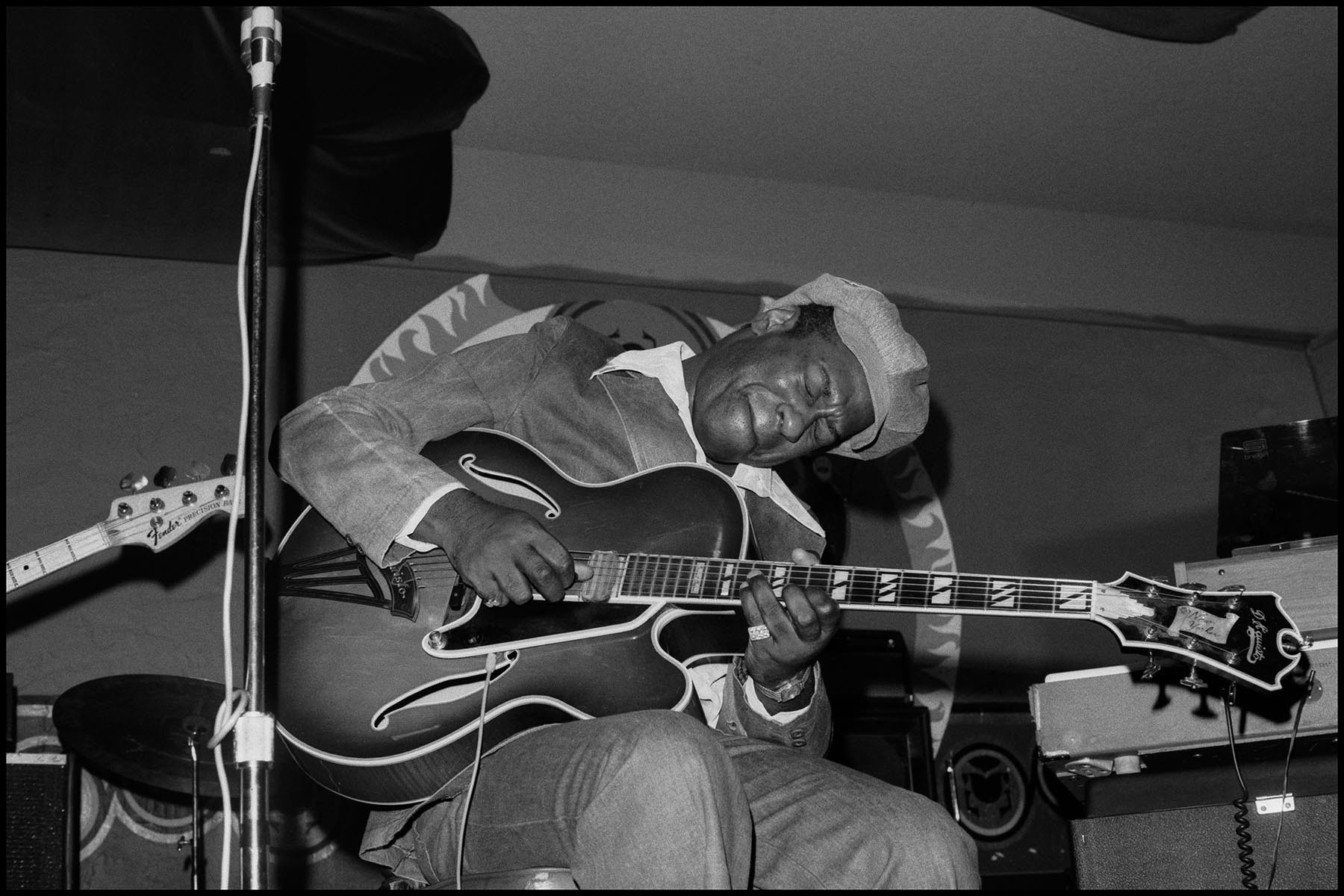 Grant Green performing onstage at the Keystone Korner nightclub in San Francisco in 1975, playing guitar and highlighting his soul-jazz pioneering and his influence on hip-hop sampling.
Grant Green performing onstage at the Keystone Korner nightclub in San Francisco in 1975, playing guitar and highlighting his soul-jazz pioneering and his influence on hip-hop sampling.
Image Credit: Janet Fries/Getty Images
Grant Green emerged from the hard bop jazz scene to become a soul-jazz innovator. A Charlie Parker devotee from St. Louis, he recorded his Blue Note debut in 1960 and embarked on a stellar five-year run, producing impeccably cool grooves on albums like Idle Moments and The Complete Quartets With Sonny Clark. He explored Latin jazz on his 1964 album Matador, featuring Elvin Jones and McCoy Tyner. Green tragically passed away in 1979 at just 43, while in New York for a gig at George Benson’s Breezin’ Lounge. However, his influence persists, particularly in hip-hop. His guitar playing has been sampled extensively on rap classics from A Tribe Called Quest’s The Low End Theory to Kendrick Lamar’s Good Kid, m.A.A.d City. Green’s soulful and groovy guitar style continues to resonate across genres.
Key Tracks: “Idle Moments,” “Jean De Fleur,” “On Green Dolphin Street”
Vince Gill: Country Music’s Vocal and Guitar Virtuoso
 Vince Gill posing for a portrait in Nashville, highlighting his vocal and guitar virtuosity in country music and his collaborations with The Eagles.
Vince Gill posing for a portrait in Nashville, highlighting his vocal and guitar virtuosity in country music and his collaborations with The Eagles.
Image Credit: Beth Gwinn/Redferns/Getty Images
It is almost unfair—as a vocalist, Vince Gill is rightly celebrated as one of country music’s all-time greats. Yet, he is equally formidable with an electric Fender in his hands. Beyond the lively chicken picking and twangy bends on singles like 1991’s “Liza Jane,” Gill has paid tribute to California country guitar legends like Don Rich and Roy Nichols on his album Bakersfield. Furthermore, Gill has contributed his guitar skills to countless other artists’ albums, including Miranda Lambert, Emmylou Harris, Patty Loveless, Kenny Chesney, Dolly Parton, and Don Henley. Speaking of Henley, Gill has been a touring member of the Eagles since Glenn Frey’s passing in 2017, performing double duty as a harmony vocalist and guitar virtuoso. Gill’s exceptional vocal and guitar talents make him a standout figure in country music.
Key Tracks: “Liza Jane,” “Oklahoma Borderline”
Garry ‘Diaper Man’ Shider: Parliament-Funkadelic’s Funky Rhythm Master
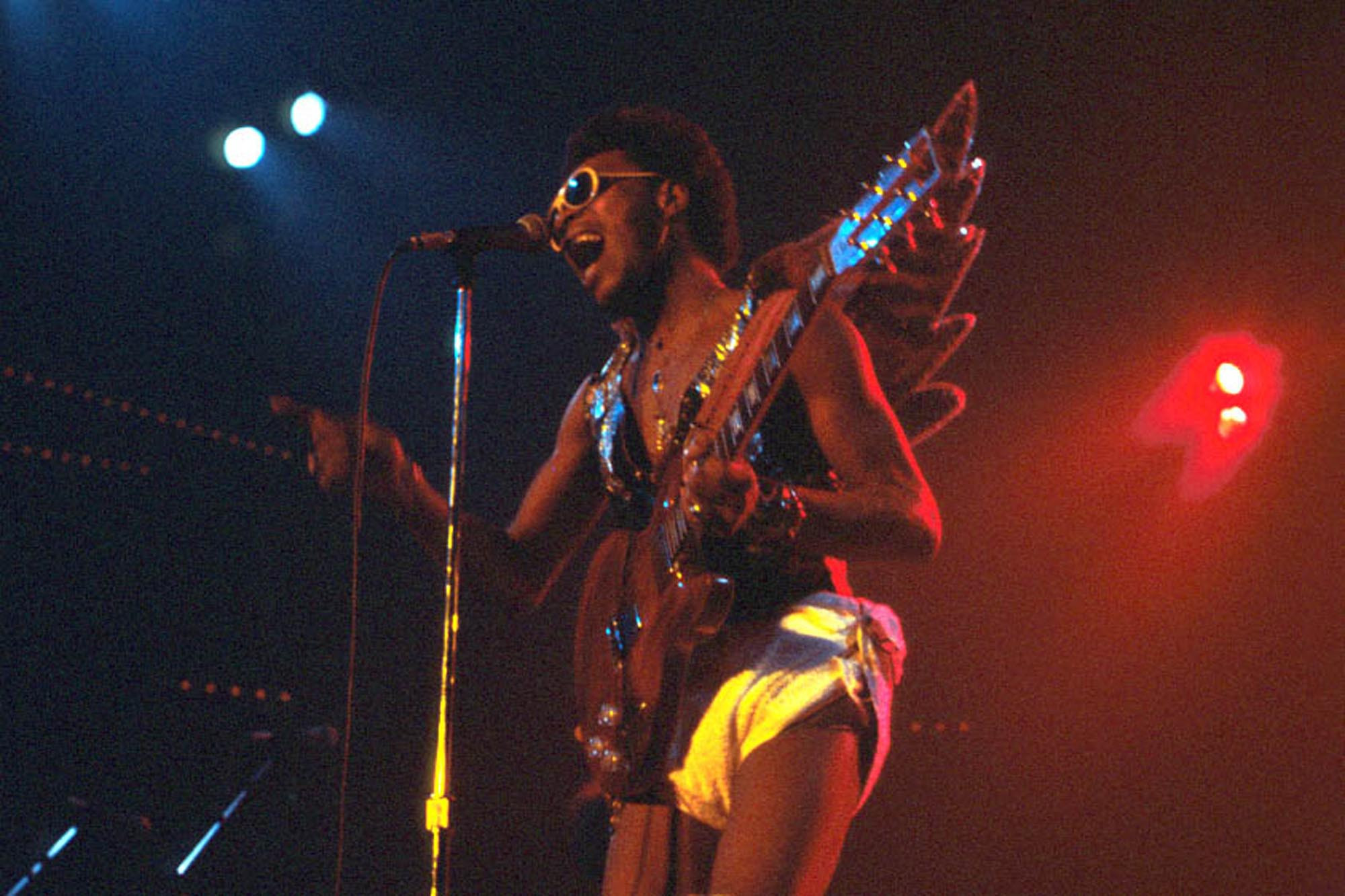 Garry "Diaper Man" Shider of Parliament performing onstage in Los Angeles in 1977, playing guitar and highlighting his funky rhythm guitar style and his role in Parliament-Funkadelic's sound.
Garry "Diaper Man" Shider of Parliament performing onstage in Los Angeles in 1977, playing guitar and highlighting his funky rhythm guitar style and his role in Parliament-Funkadelic's sound.
Image Credit: Michael Ochs Archives/Getty Images
When asked about his onstage attire, often consisting of little more than an oversized diaper, Parliament/Funkadelic guitarist Garry Shider quipped, “God loves babies and fools. I’m both.” While initially recognized for his searing, distortion-laden leads on Funkadelic jams like “Cosmic Slop,” Shider was also a master rhythm guitarist, evidenced by his insistently funky playing on “One Nation Under a Groove” and “Atomic Dog,” both of which he co-wrote. In addition to his “Diaper Man” persona in Parliament/Funkadelic, he was known as “Starchild” in Bootsy’s Rubberband and served as music director for the P-Funk All Stars. His post-P-Funk career included collaborations with Paul Schaffer and the Black Crowes. Shider’s funky and versatile guitar playing was integral to the Parliament-Funkadelic sound and legacy.
Key Tracks: “Cosmic Slop,” “One Nation Under a Groove”
Rolling Stone‘s comprehensive list of 250 Greatest Guitarists stands as a vibrant testament to the enduring power and diversity of the guitar. From blues pioneers to metal gods, indie innovators to funk masters, these musicians have collectively shaped the landscape of modern music. Exploring this list is an invitation to delve deeper into the rich history of guitar playing and appreciate the unique contributions of each artist to this ever-evolving instrument.
